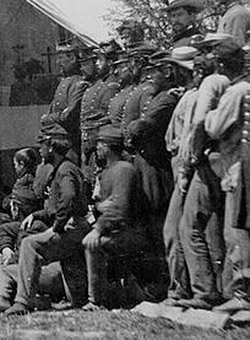
Please send all Checks and Money orders to :
Dave Taylor P.O. Box 87 Sylvania, OH 43560
419-842-1863
Click Here to E-mail Us!


14 12
~~~~~~~~~~~
LAYAWAYS ARE WELCOME:
Need to split your order into multiple payments? No problem! A simple 20% earnest money deposit will hold your item for you.
You can then pay it off in easy installments that fit your budget.
Read Terms Here
~~~~~~~~~~
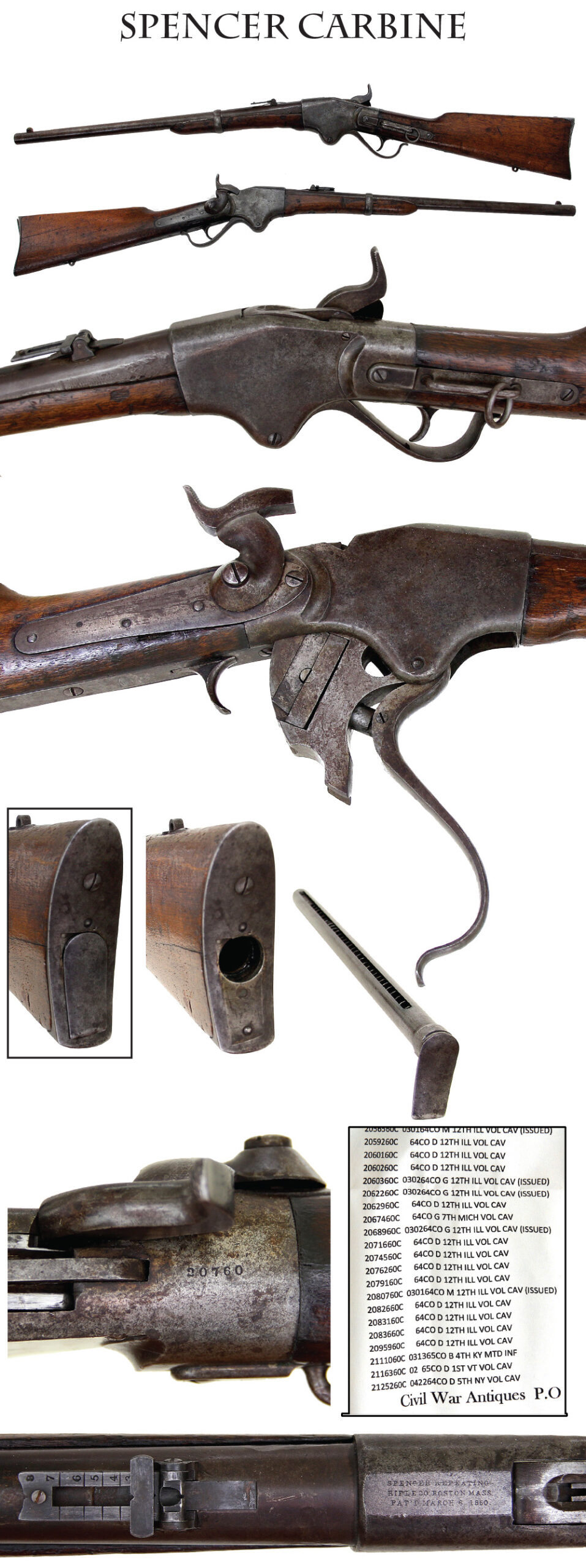
14-12-01 … Likely 12th Illinois Cavalry Spencer w/ LowSerial Number:
Serial numbers of Civil War arms, when they had numbers,were not systematically recorded so it is not easy to identify one to a particular soldier or unit, but here is a really, really good candidate for the12th Illinois Cavalry: Model 1860 Spencer Carbine #20760. In the known records, not only is this gun s serial number surrounded by a bunch from Companies D, G, and M of the 12th Illinois (with a stray showing up in the hands of the 7th Michigan at some point in 1864,) several of them were recorded when issued to the unit on March 1 and March 2, 1864 which corresponds with known deliveries of Spencers in the low 20,000 range at that time. We know Spencer was delivering 2,000 carbines per month. Starting in September 1863 his first shipment started near serial number 11,000. Five to six months later would put the serials in the 20,000 to 23,000 range (roughly). The carbine has nice warm brown tones to the wood and a good wood to metal fit of both the fore stock and butt stock. There are the usual dings and small divots proving the gun had actual use in the field. The fore stock shows some loss at the left top of the barrel channel at the receiver, which is fairly common. The butt stock shows a small dented area above the side bar where the sling ring and snap hook of thetrooper s carbine sling would have hit it, a small divot below the lockplate half way back. It has a minor hairline crack running a few of inches up from the butt plate parallel to the magazine tube, which is commonly seen on Spencers. Not offensive. Sturdy andsolid. Mechanically functional, the magazine tube draws fine, the sights are in place, with ladder and bar on the rear sight. Spencer manufacturing and patent marks are clear on the receiver, as is the serial number. The metal is smooth with a deep pewter color showing some plum brown on the barrel, some purple of faded caseon the receiver along with some brown over silver gray. Bracket for the butt swivel is present, but the swivel is long gone. This could be replaced, but I would leave it as is: many were probably removed by the troopers since the carbine sling andside bar rendered the butt swivel superfluous. This is a nice gun with strong regimental association, and the unit did see some good action. The 12th Illinois Cavalry recruitedin early 1862 and was sent to Virginia in June, 1862, when it saw service at Winchester and elsewhere, eventually joining the Army of the Potomac in time toserve in the Cavalry Corps in the Gettysburg Campaign, losing 3 killed and 4wounded in the first day s fighting and taking part in the pursuit to Falling Waters, etc. In November the regiment went home on veteran furlough and when they returned were assigned to the Department of the Gulf and likely at this period received their new Spencers. Thus armed, they fought in the Red River Campaign under Banks, and took part in several expeditions, skirmishes by detachments, etc. This is a real veteran of the Civil War and is a nice looking gun. You won t be disappointed to have this on your wall
… $2,250.00 SOLD
Click Here to E-mail Us!
Call us @ 419-842-1863
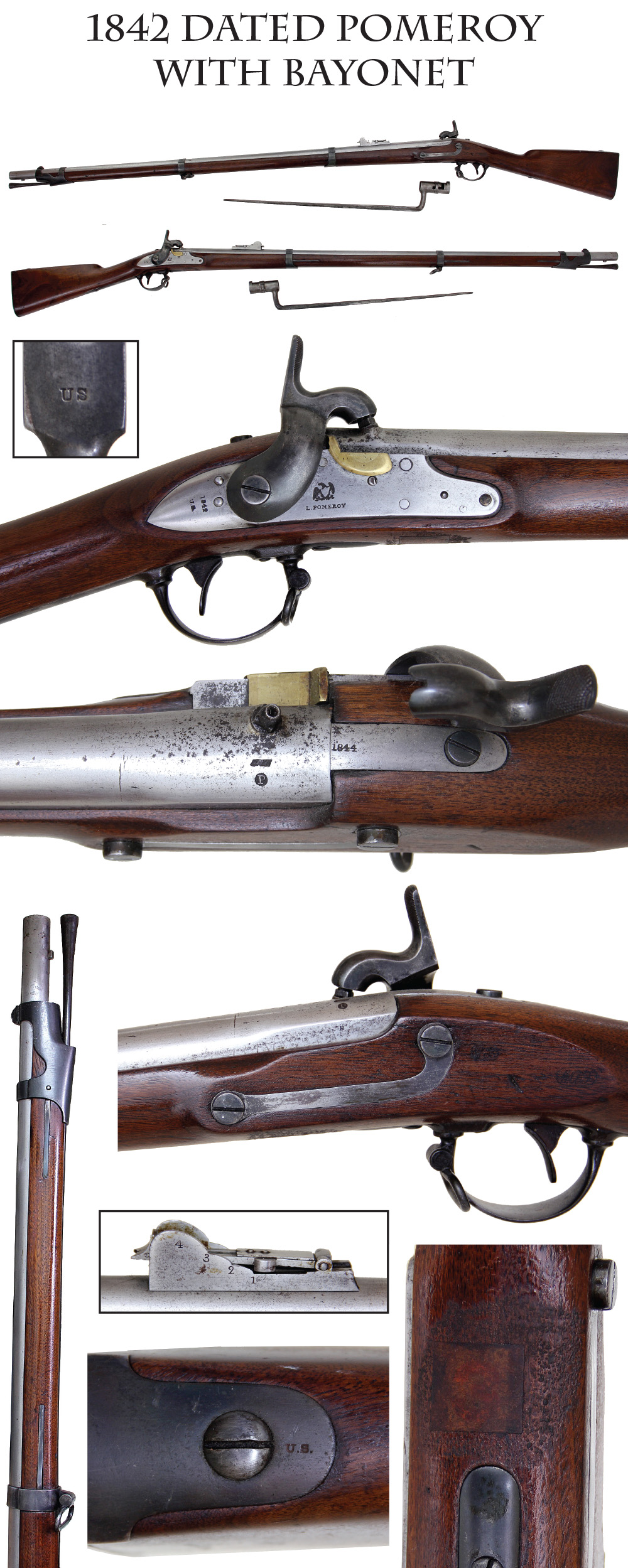
14-12-02 … Rifled and Sighted m1840 Musket by Pomeroy With Arsenal Conversion and Bayonet …
Also known as the Model 1835 and 1835/40, this was the last of the standard US infantry flintlock muskets made for the US Army. It introduced a number of changes used on the subsequent US models such as interchangeable parts. A few model arms of this 1840 pattern were made at Harpers Ferry, but when production actually started in 1840 they were produced only at Springfield and by two contractors: Nippes and Pomeroy. Whenthe government decided to alter its flintlock arms to percussion these were automatically classified as candidates for the arsenal cone-in-barrel conversion and most were altered before leaving government arsenals, being regarded as equal to the M1842 percussion arms. The heavier construction of the musket and thicker barrel also made it a prime candidate for rifling and use of the new minie ammunition that became standard with the 1855 series of arms. Ours is a very nice 1842 dated example by Pomeroy, who produced about 7,000 of them between 1840 and 1846. Very clear 1842 over U.S. marks at rear of hammer and eagle over L. Pomeroy forward. Very clean lock plate and metal in the bright. Some slight softness to the marks, but in this case it appears to befrom the arsenal cleaning when they converted the musket to percussion by removing the external flintlock parts, shaving down the flashpan, etc. Thebarrel shows clear inspection and proof marks and a distinct 1844 date on the breech plug tang, which is acceptable on these guns since the parts were interchangeable when they were disassembled for conversion to percussion and then for rifling and sighting starting in 1856. Nice light brown color and edges to the wood,and two visible ink cartouches on the offside opposite the lock. The wood was gently cleaned and varnished by a previous collector. Very few dings or handling marks to the wood. The only defect is a small square patch that was inlet on the underside near the trigger guard tang. Metal is smooth and in the bright with the exception of some firing corrosion around the nipple and a slightly darker toneto the hammer and mounts. All bands,springs, swivels, bayonet stud and sights are in place, including the complete model 1855 long range rear sight. Bore is goodand mechanically functional. Ramrod is an original trumpet head 1835 / 42 rod. When the 1816 pattern muskets were found to be too weak for rifling the government moved these 1840s to the head of the lineand they quickly made their way into the hands of troops on both sides in theCivil War. They were sturdy and dependable enough that they were in the field throughout the conflict and we even find the pattern of 1864 cartridge boxes made for their elongated .69 caliber cartridges.
Optional Original 1835 / 40 / 42 bayonet available for
… $175.00
Musket alone … xxi
… $1,250.00
Click Here to E-mail Us!
Call us @ 419-842-1863
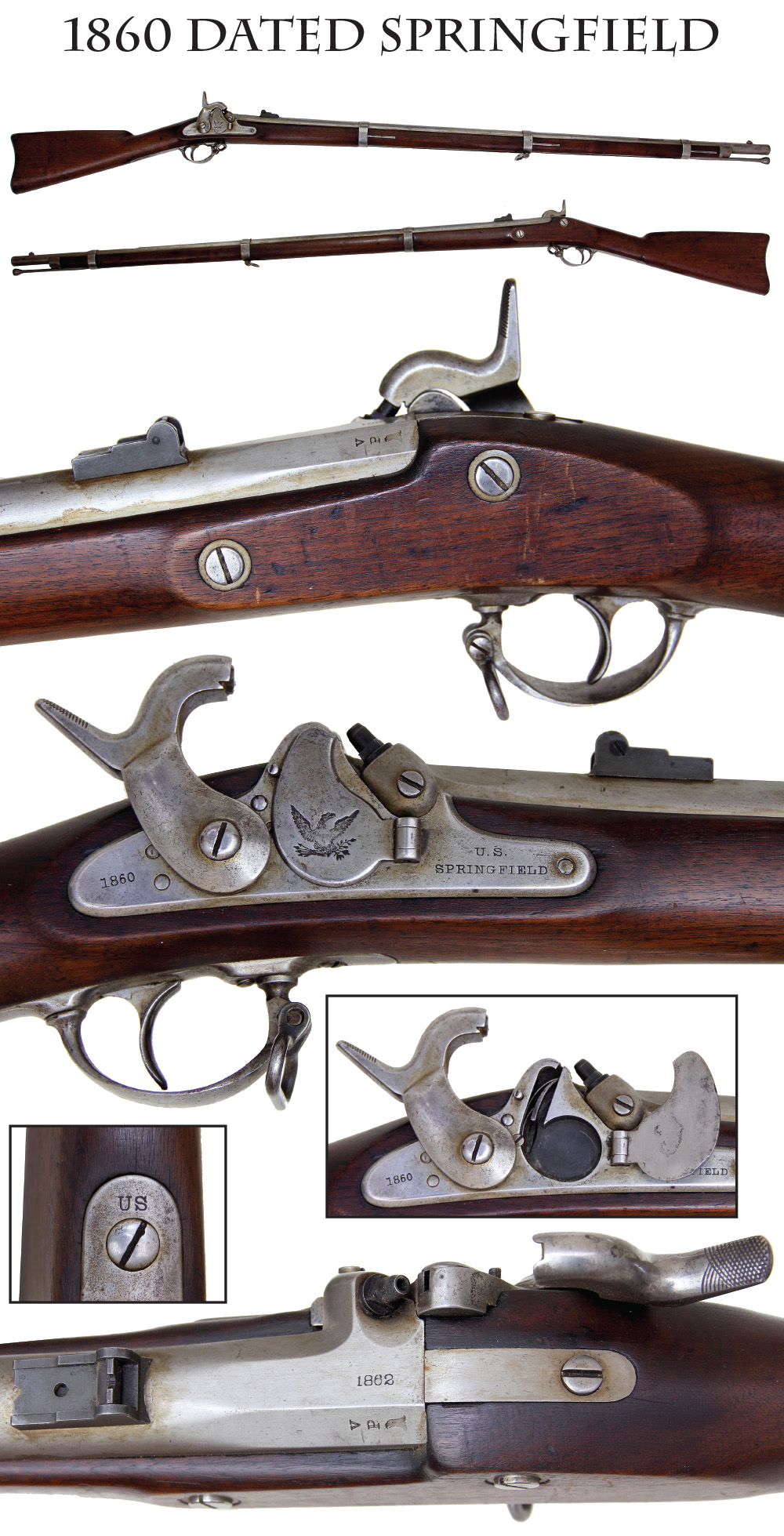
14-12-03 … M1855 Rifle Musket with Springfield M1861 Barrel:
Overall VG to near fine. Interesting as this musket carries a barrel from Springfield Arsenal bearing an 1862 date. Since this barrel is a darn rare commodity to find on the loose, I am inclined to believe the barrel was replaced during the war. Clean steel, strong markings, VG wood, no visible cartouche, late 1864-5 era rear sight. Whether this musket was upgraded in 1864 or by a collector in 1964 I cannot say with certainty. What I can say is that it is a rare item regardless. Every part is original and every part except the rear sight is an early rare item. Great early ’55 musket … adjj
… $2,250.00
Click Here to E-mail Us!
Call us @ 419-842-1863

14-12-04 … Model 1884 Trapdoor Rifle …
Tons of barrel blue and dark case color is left on this 1884 trapdoor. Numbered 323901, this rifle falls fairly early in the series, which started numbering at about 300,000. It has the US/Model/1884 breechblock, but canbe seen using up the old 1873 parts in the lockplate markings of an eagle next to U.S. / Springfield / 1873. Buffington rear sight, sling and stacking swivels present, though it needs a cleaning rod, which is not too hard to find. Barrel is beautiful, about 100% blue,sharp V/P/eagle and P inspection and firing proofs on left breech along with asmall A. Crisp breech block marks, some smoky purple case color on sides of the receiver and hammer. Wood was cleaned as some point to a light brown, blurring the cartouches that are there but not readable. Minor handling marks, no cracksor chips. A good gun that was probably issued to a regular army unit soon aftermanufacture for service out west and later reissued to a state unit for theSpanish American War. The slightly heavier bullet of the model 1884 packed a good punch and gave range on the plains, but in Cuba the black powder rounds of the US trapdoors served mostly to attract the fire of the Spanish Mausers. A most affordable US martial arm … ppd
… $495.00 SOLD
Click Here to E-mail Us!
Call us @ 419-842-1863
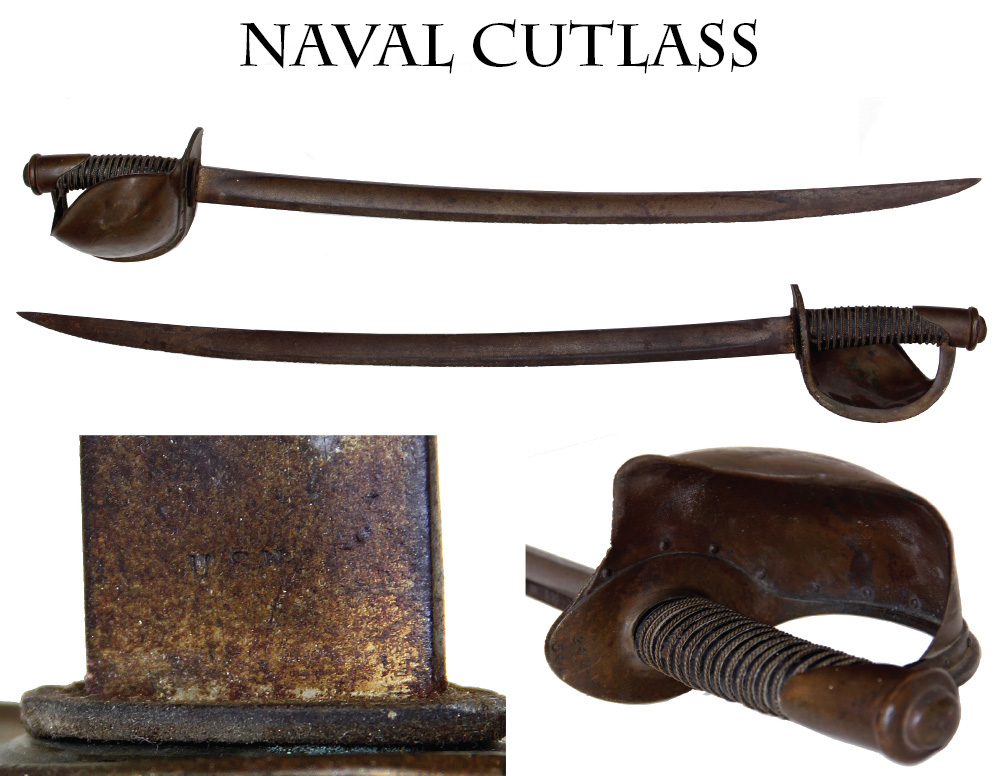
14-12-05 … 1860 Pattern US Naval Cutlass by Ames with Twisted Wire:
The 1860 pattern cutlass was supplied in the thousands to arm sailors who might still be expected to take part in boarding actions where fighting at close quarters might not permit reloading of firearms. This is an attic condition piece that amazingly appears to still retains the wire wrap binding on the leather wrapped grip. The vast majority of these had the wire removed at some point in their long service toavoid verdigris and tarnish. This wire appears to have been on the grip forever. This one has an untouched deep aged patina to the brass cup guard and hilt and even has its leather washer at the blade shoulder as well. The blade would clean up some, but I prefer to leave things as is and this one shows a thin brown tarnish overall that is a build up of grease, nicotine, and plain old-fashioned grunge. USN marking visible, other markings buried in the rust … bej
… $450.00 SOLD
Click Here to E-mail Us!
Call us @ 419-842-1863

14-12-06 … Rare Iron Hilt M1880 US Army Hunting Knife:
These wide blade knives were designed as a multi purpose tool and weapon for the US Army soldiers on the western frontier. This is one of the first 1002 which were produced at Springfield Arsenal in 1881. Only the first 1002 had steel (iron) hilts and guards. These iron guard knives are extremely scarce. A near perfect example is offered for sale on the trapdoor collector web page at $3,495.00! In 1882 the production changed and they were made with brass guards. That pattern is quite common. Blade is 8 long, 2 wide. Handle is 4 maple. Originally these steel hilt knives were issued in so-called Varney scabbards which were elaborate brass mounted and brass hinged affairs. Our knife is housed in the standard 1882 pattern scabbard with brass hook. Knife shows use and age with some pitting on the guard and chipping on the pommel of the grip. The face of the pommel still bears the SWP 1881 stamping. The scabbard is complete with some weakness in the area where the leather tongue is riveted to the brass belt loop. The leather is intact, just has some weakness there. A rare and desirable Indian War weapon that most collectors never get a chance to own. Priced darn fair at
… $550.00
Click Here to E-mail Us!
Call us @ 419-842-1863
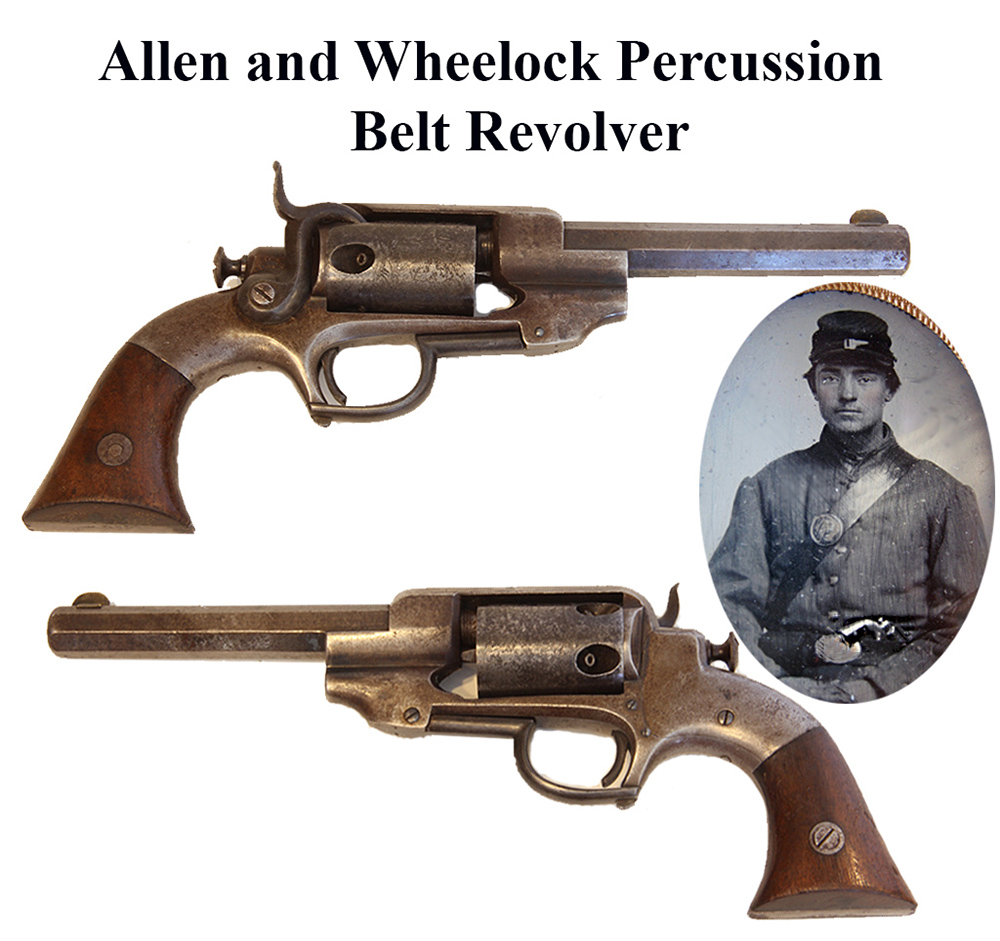
14-12-07 … 31 Caliber Allen & Wheelock Belt Revolver:
A very solid example of this scarce Civil War sidearm. It is believed that less than 1000 of these guns were produced. This one has a five inch octagon barrel, five shot cylinder, and spring loaded lever catch. These A&W large size percussion guns are interesting as the design incorporates a hinged trigger guard which doubles as the handle of the rammer assembly for seating bullets while loading. You unhinge the trigger guard, push it forward, and it levers the ball plunger into the chamber in the cylinder. Ingenious really. 100% original, 100% complete, mechanically perfect. Hints of finish in protected areas. Sharp markings on side flat of barrel “Allen & Wheelock Worcester Mass / Allen’s Patents Jan 13, 1857, Sept 7, 1858”. Made circa 1858 – 1861. Scarce early war gun
… $750.00 SOLD
Click Here to E-mail Us!
Call us @ 419-842-1863

14-12-08 … Civil War Flag Tassels:
The real deal … “extra quality”, woven bullion and fringe battle flag tassels off a Union Army battle flag. Constructed along the same lines as officer’s bullion hat cords. I removed these wonderful tassels from the scabbard rings of a Confederate Frolich cavalry scabbard housing a Confederate staff officer’s sword that I purchased from a family in Colorado some years ago. The Union soldier who captured the sword must have used the regimental flag tassels to hang the sword in a wall display in his home or GAR Hall. Tassels are overall Very Good. Some fraying, a couple weak spots, but overall solid and very attractive. These are darn scarce items and these are absolutely dead-on wartime tassels
… $495.00 SOLD
Click Here to E-mail Us!
Call us @ 419-842-1863
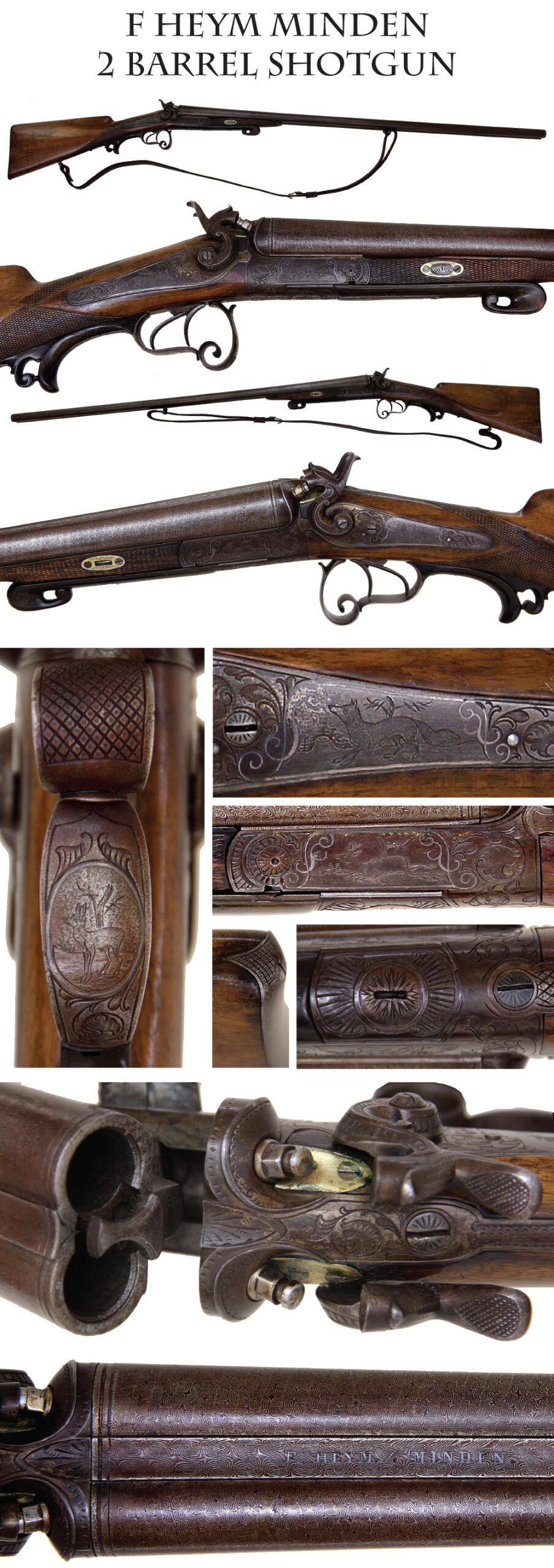
14-12-09 … Elegant Damascus Barrel Double Shotgun by Frederych Heym …
Very elegant gentleman s hunting weapon of the utmostquality, with Damascus twist steel barrels and beautifully engraved hardened steel receiver and mounts. 12 gauge center fire cartridge ignition. Heym founded his firm in1865 and is well known for his high quality shotguns, double rifles, and drillings. This is a great example of his work. Checkered forend with engraved wedge, long barrel lever, hinged undercarriage at breech showing very elaborate scroll and vine engraving with a central hunting motif: a fox on oneside, a deer on the other, and a rabbit on the round panel on the trigger guard. Very attractive purple muted casecolors and bluing overall, going to a slight plum brown on portions of thebarrel, with just some brown speckling on the trigger guard and touches of silver gray poking through here and there. Wood is excellent, with checkering at wrist. Screw heads are engraved.Trigger guard with an eye-catching reverse-S scroll and handrail. Old adjustable leather sling in place. Beautiful maker name and location in the barrel rib F. HEIM / MINDEN showing original lustre. A very high class and pretty hunting weapon that shows artistry in arms. This was brought into our local show by a lady who inherited it. I fell in love with it and made her a good strong offer to make sure I got it bought. A truly beautiful antique … hjjrt
… $1,150.00 SOLD
Click Here to E-mail Us!
Call us @ 419-842-1863

14-12-10 … Secondary Confederate Musket / Rare Whitney Long Enfield Rifle Musket …
Eli Whitney, Jr., knew how to make hay while the sun shined. When the holdings of the bankrupt Robbins and Lawrence firm were sold at auction in 1858 he bought 5,000 sets of the solid type Enfield barrel bands and some 5-6000 stock blanks they were using to fulfill and British contract for 1853 Enfields. Whitney then put them to use on a variety of his own products from 1859 to 1862. His Long Enfield Rifle Musket used a 39-inch .58 caliber barrel and US style hammer and bolster, but preserved the Enfield style stock, butt plate, flat lock plate, winged brass washers in the lock screw holes, and of course those Enfield style barrel bands. Flayderman estimated a production run of 3,500 guns of this pattern but it could have been higher. Maryland bought some 2,000 of them, another 1,225 went to Georgia by February, 1861, and he even sold 75 to a Mississippi militia company in 1860. Others went to northern retailers, individuals and groups. 100 went directly to the US Ordnance Department in August, 1861, and others may have been included in the 18,000 long Enfield rifles that Schuyler, Hartley and Graham sold to the US Ordnance Department, but it is a gun with strong southern connections. This one has wood with decent edges, rich tones, very few dings or dents, and no cracks or chipping. Three initials are very lightly and neatly inked on the offside opposite the lock reading AMW and another set more crudely carved reading JEG or JEC appear on the butt with some inked letters beneath. Some corrosion near the nipple and on the upper lockplate from firing and slight burnout of the wood below the hammer. Clear E. Whitney stamp on lower edge of lock plate. Iron butt plate, brass nose cap instead of pewter, which is a variation noted by Moller. One variation is the placement of the upper swivel on the middle band rather than the band nearest the muzzle, in keeping with US practice. Rod, swivels, and springs in place. Both sights present, the rear sight being the second type 1858 with the straight back. Bore and mechanics good. A scarce early and prewar rifle musket with quite a story totell. Totally appropriate to display with Confederate infantryman s effects
… $1,850.00 SOLD
Click Here to E-mail Us!
Call us @ 419-842-1863

14-12-11 … Archibald Reed Double Barrel Percussion Shotgun …
Another gentleman s hunting weapon, but this one showing typical English restraint in the refined decoration. Archd. Reed. City. Road. London in the rib, and Archd.Reed, London on the lower receiver. Delicately engraved bordered flat lockplates with floral motifs, vegetation and pheasants. The hammers have great architecture: flat shanks with an S-curve, rectangular blocks with floral motif from which spring curved thumb pieces on top and and flaring conical cups forward. Double triggers, recurved guard and handrail. Elaborately engraved tang between the hammers and engraved screwheads. Checkered wood fore-endsecured with one wedge; checkered wrist with small shield shaped inset gilt escutcheon plate, unengraved. There isa thin wrist crack forward of the escutcheon, even with the rear of the lockplate. This has been repaired. The wood tones are nice overall and there arevery few handling marks. The butt plate shows light engraving as well, and a few scratches. There is some minor firing corrosion near the nipples, more onthe right barrel than the left, and the right nipple correspondingly has more use, showing steel where the left nipple is shows gilt coloring. The barrel finish overall is very nice, showing Damascus striations in a blue turning plum brown with hints of purple. This gun was used by my old friend and gunsmith Dick Harvey of Sylvania, who passed away last year. He was an avid muzzle loading trap shooter. The nipples are new as are the platinum blow-outs. Interestingly I have some wonderful background stories on Archibald Reed. Published are the transcripts of an 1850s trial, where a burglar was prosecuted for stealing shotguns and pistols from Reed s shop. I will include the transcript with the gun. It is very on the spot with testimony that even describes the workshop and the guns. Neat early shotgun circa 1855. Top quality in beautifully understated tones. One heck of a lot of quality for … bbe-harv
… $475.00 SOLD
Click Here to E-mail Us!
Call us @ 419-842-1863

14-12-12 … REAL 1861 SPRINGFIELD DATED 1861!
The holy grail for Civil War collectors is a true 1861 Springfield actually made in 1861 at the Springfield Arsenal. The quintessential infantry arm of the Civil War, the 1861 was the improved and simplified version of the 1855 rifle-musket and was in high-demand at the beginning of the war. Ordnance responses to the many requests for them indicate they were being issued as quickly as possible, intended for troops in the field, and where necessary were being issued to the flank companies of regiments until the entire unit could be re-armed. Contracts with outside manufacturers were quickly let for production of this arm, but with rare exceptions most of those contract guns did not get to the field until 1863. The actual Springfields were in the field in 61. This gun saw action, and is in very good shape and is a true 61 with the proper 1861 barrel fitted with the proper early 1855 – 1861 pattern stepped short range rear sight which was done away with by Springfield during 1862. The gun saw some use: there is some light salt-and-pepper pitting around the nipple from firing (the fulminate of mercury in the percussion caps was far more corrosive than the black powder) and the barrel date and proofs are pretty much obliterated. A couple of small numbers or letters are visible at the breech and breech plug tang, and there is a painted 18 on the butt stock, likely a rack number since it is oriented to be read as the musket stands upright. Overall the metal is smooth, with an attractive brown age patina. Nose cap and barrel bands show a bit darker. Correct rod, swivels, bands and springs all in place. Lock plate shows a very sharp 1861 aft of thehammer, and a crisp eagle above and left of US over Springfield forward. The clean out screw on the bolster shows some turning in the slot but is not all buggered up. Lock plate and hammer both show matching patina mixed with some very faded case colors. Slight shrinkage of the wood around the breech and breech plug tang, but nothing unsightly and everything istight. The best part is the very visible Springfield cartouches on the offside opposite the lock, showing that it is unquestionably a product ofthe US Arsenal at Springfield, Mass. This is a Springfield from muzzle to butt plate. The real deal … a true 61 Springfield … waejjx
… $1,975.00 – SOLD
Click Here to E-mail Us!
Call us @ 419-842-1863
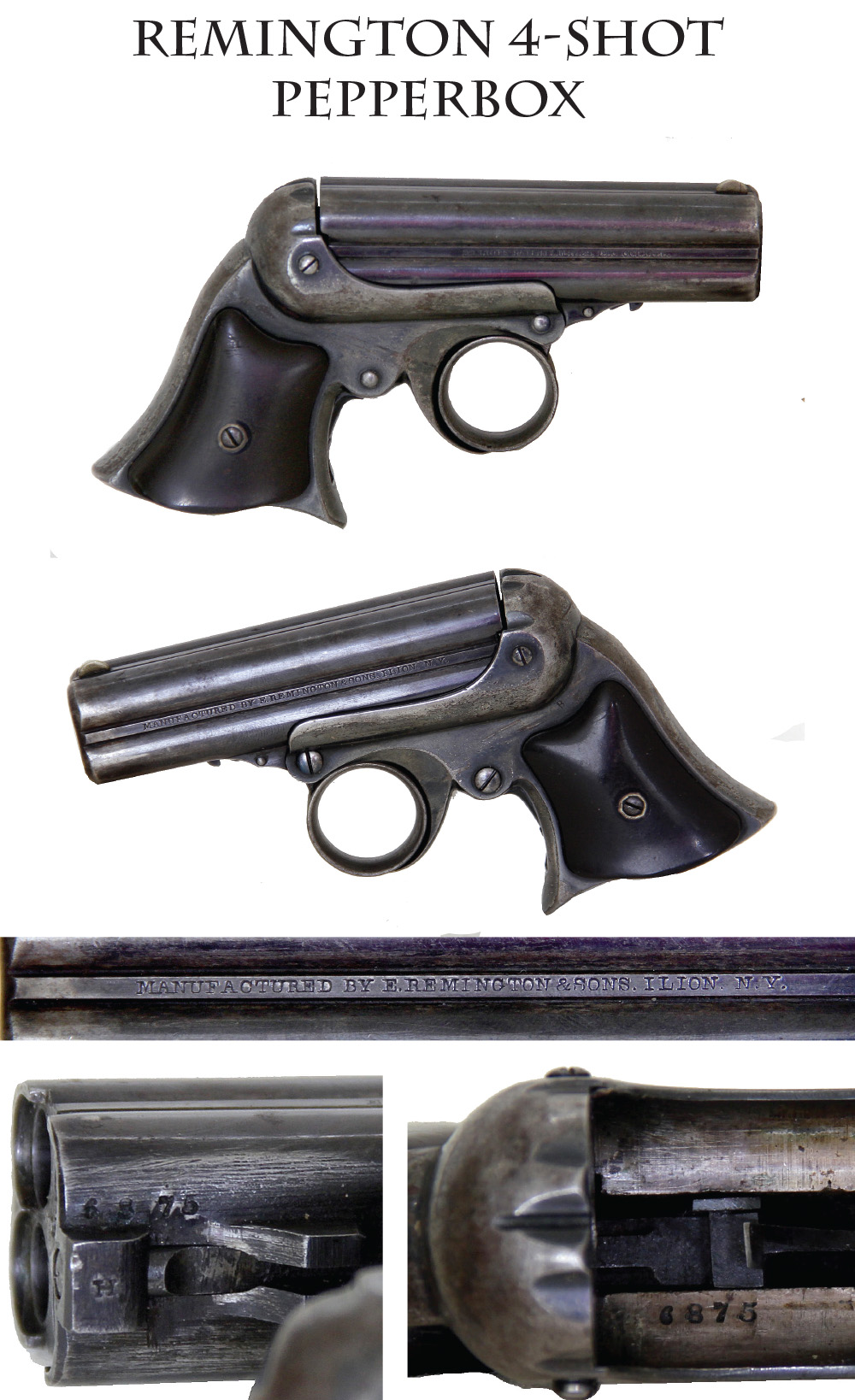
14-12-13 … Near Fine Condition Remington-Eliot 4 Shot Pepperbox
… With a ring trigger that made it hard to tangle up in a pocket or fire by accident, the .32 rimfire four barreled Remington-Elliott “pepperbox” provided some fire power for a close-infight across a card table, out a stage coach window, or in an alleyway of SanFrancisco’s Barbary Coast. The trigger actuates a rotating firing pin that moves to the next round as it is pulled. This one is a really nice example with 50%overall original bright factory blue finish: strong on the barrel assembly, 80%or better, washing out toward the muzzle. Less on the frame, about 30% in the recessed areas and worn off the high points from handling, but leaving a deep pewter tone mixed with purple. 100% original and complete, and mechanically perfect. Excellent grips and Remington maker’s marks onthe left barrel frame and Elliot patent markings on the right. Serial number 66875 under the barrel and inside the slide chamber. Perfect for Civil War orearly western display with production starting in 1863 and running into theWild West era. One of the nicest I’ve found lately … bge
… $595.00 SOLD
Click Here to E-mail Us!
Call us @ 419-842-1863

14-12-14 … Sharps and Hankins Navy Carbine With Leather Barrel Cover …
Sharps and Hankins made about 8,000 of these .52 single-shot rimfire breech loading carbines in several variations from 1862 to 1865,sometimes also called the Sharps and Hankins Model 1862 Carbine. The US Navy bought just a tad under 6,700. This is the second model, with the firing pin mounted on the recoil shield, and numbered 6967 throughout. Very nice condition walnut stock and brass buttplate. Silvery gray steel receiver with some darker gray cloudy areas that might be the remains of case color. Very clear Sharps Patent and Sharps and Hankins manufacturer s markings on either side. The action works fine, the trigger guard lowering to slide the barrel forward to permit loading. Frontsight, rear sight and elevation leaf in place, as is the butt swivel that was designed to take a sling looped through the swivel and buckled around the barrel. Rather scarce is the very nice condition leather covering on the barrel. These Navy carbines sport a 24-inch barrel with a collar at the muzzle and screws to keep in place a sewn leather sheath that protects the barrel and front part of the action from the effects of sea spray and salt water. The covers are often gone. This one is complete and has just minor crackling, wear and abrasions at the edges. The navy envisioned these being used aboard ship, but also in the hands of landing parties. In the western waters, sailors fighting the river war were often called upon to deal with ambushes and harassment from Confederates ashore and not only were there many smaller boat actions, sailors were sometimes took part in larger actions such as the assault on Fort Fisher. Sharps made weapons are a collecting field of their own. This is good piece for the Sharps collector, the Navy collector, and the collector of US martial arms … aajj
… $1,350.00 SOLD
Click Here to E-mail Us!
Call us @ 419-842-1863
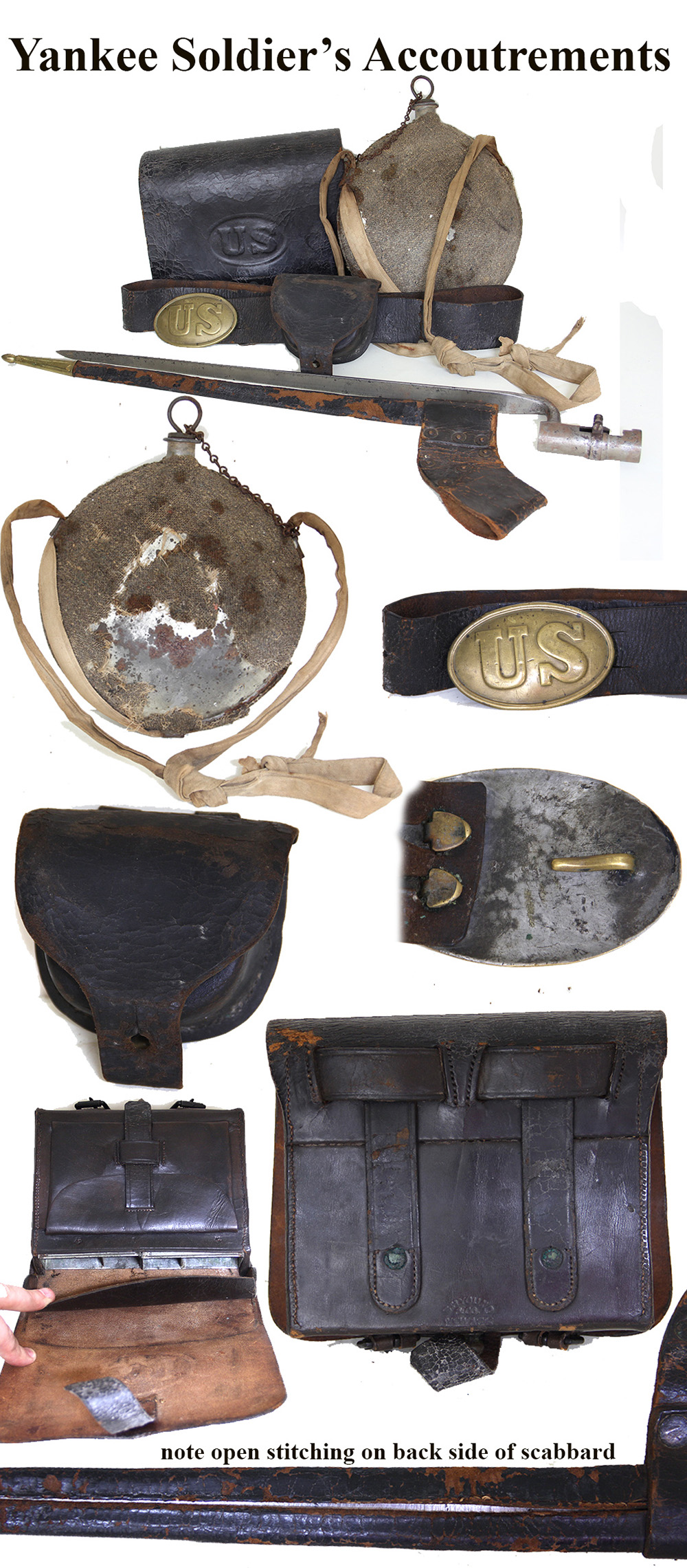
14-12-15 … Yankee Soldier’s Accoutrements …
Typical Civil War soldier s accouterments: waist belt with plate and cap box, bayonet and scabbard, infantry .58 caliber cartridge box with tins, and canteen. The canteen is the New York depot version of the 1858 canteen with a chained stopper. Has the original sling and stopper. Gray wool issue cover about 95% on one side and 60% on the other. Displayed with the good side up it looks great. Has stains. Waist belt is solid, some alligatoring and finish loss, no retaining clasp at the belt end which is typical of actually issued belts where the soldiers cut off the keepers as unnecessary. Sports a nice arrow back oval US plate withbeveled edges to hook and arrowheads. Completesolder fill on reverse. A nice non-excavated example. Cap box is the regulation pattern with two belt loops, one-piece cover and an inner flap with ears. As is usual, no fleece or pick, but a good solid example. Rifle box is the 1864 version of the 1855 box with an embossed US on the outer flap, made to be worn on a shoulder sling or waist belt andcarry .58 caliber ammunition in two tin liners or magazines. All loops and buckles in place, latch tab, inner flap, ears and implement pouch along with the tins. Sharp S.H. Young Maker stamp at lower rear of box, a very well known US contractor. Minor wear and alligatoring to the finish from flexing and use, but a very solid box. 58 caliber bayonet and scabbard. Regulation issue bayonet for the .58 caliber rifle musket with US at base of blade, functional locking ring, with original leather scabbard and belt loop. Along with the cap box, the bayonet and scabbard completed the soldier s belt set. The bayonet is generally an even silver gray overall, but with some light brown specks and a couple of broader brown spots on the socket. The scabbard is good and complete, but shows finish loss and an open seam. A nice set of Yankee gear
… $1,195.00 SOLD
Click Here to E-mail Us!
Call us @ 419-842-1863
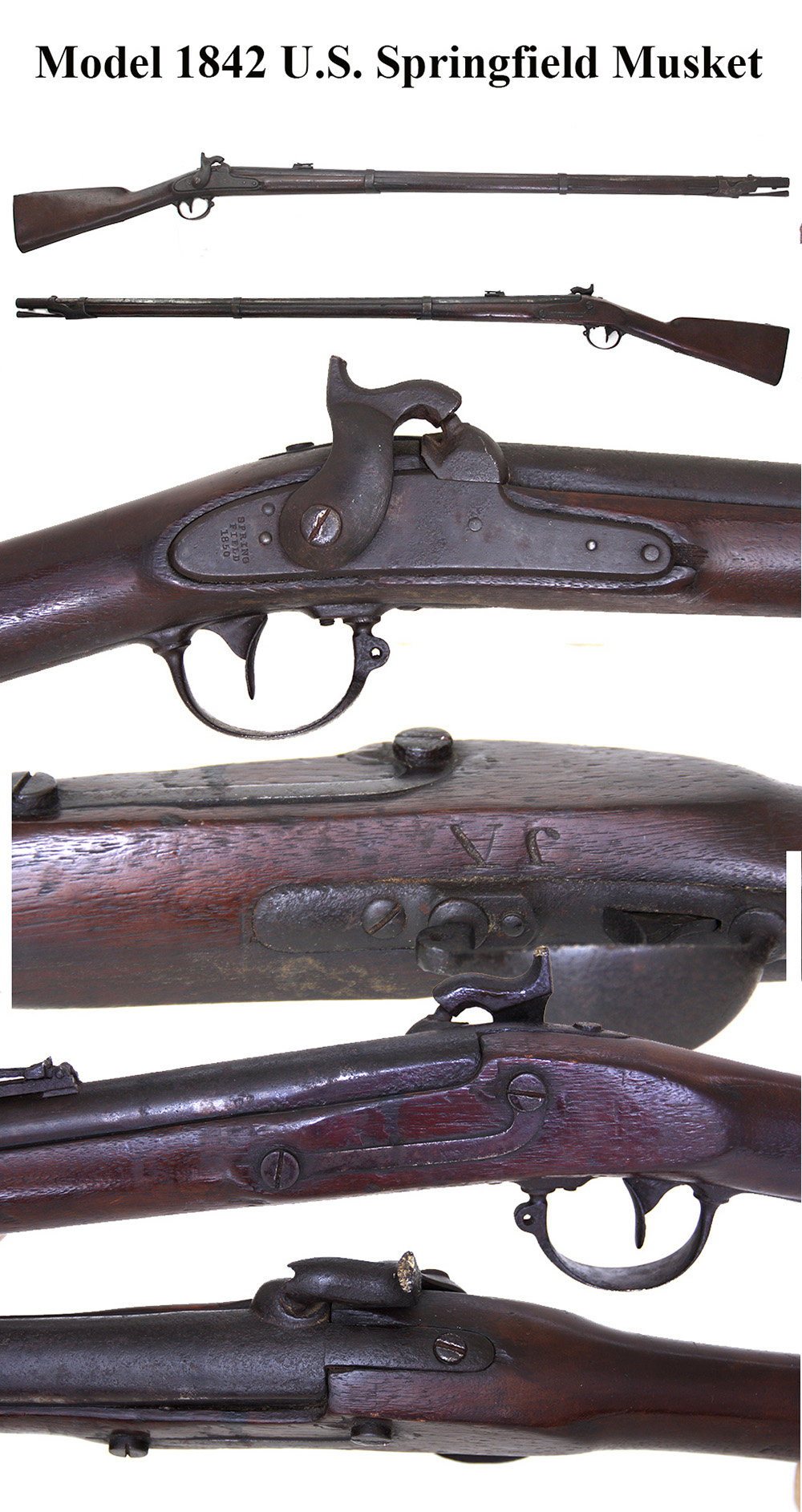
14-12-16 … 1850 Dated Model 1842 Springfield Musket …
Crusty, attic brown 1842 musket. These were the first percussion long arms for general issue to infantry and also the last of the smoothbore .69 caliber muskets firing round ball, or more commonly “buck and ball.” Essentially apercussion version of the 1840 flintlock, these were the standard US infantryarm until the 1855 series, but were produced in great enough quantity to seeservice on both sides throughout the Civil War. This one has a crusty brown surface overall with a light surface rust in places. The barrel shows some bright spots hereand there, still has its bayonet lug. Interestingly it sports a crusty Smith carbine rear sight that has been there forever. The gun remains a smoothbore and has the original rod, bands and springs in place. The swivels are gone. The hammer spur is brokenoff and there is a small chunk of missing wood at the forward end of the lockplate. Despite these battle scars the gun is complete and very honest looking. The plate shows a clear Spring/field/1850 stamp to the rear of the hammer, the eagle forward is worn away. There is some shrinkage ofthe wood at the breech and a slight bowing out of the left side next to the barrel. A period owner’s initials “JA” have been lightly carved on the underside next to the trigger guard, and with some imagination you can make outpart of the eagle proof on the barrel. A real “old-timer” that would look just fine on the wall or leaning in the corner, as it probably did for a century and a half after someone brought it home from service. You won’t find another complete US musket priced this friendly
… $525.00 SOLD
Click Here to E-mail Us!
Call us @ 419-842-1863

14-12-17 … Freshly Found Johnny Reb Cavalry Saber:
I purchased this at a local auction three days ago as I type this. The auctioneer related that the consignor’s family had found the saber in a barn in Horry County, South Carolina circa 1900. This was described in the auction catalog as well. Fifty years ago the family purchased a copy of William Albaugh’s book on swords and they marked the page where their saber was illustrated. Tucked into the book was a photo post card of a farmer and barn from the early 1900s which I will include with the saber. Saber is a classic Haimann example made in Columbus, Georgia. Condition is overall very good showing all its age with dignity. Blade has a deep, undisturbed, aged rust patina. Grip wrap (oil cloth) and single strand iron wire are intact. 36 inch blade 42 inches overall. Grip was painted silver long ago and the silver paint was removed leaving traces in protected areas. The real-deal … Confederate cavalry saber in solid condition
… $1,750.00 SOLD
Click Here to E-mail Us!
Call us @ 419-842-1863

14-12-18 … Georgia State Arsenal Confederate Bowie …
Classic Confederate D-guard Bowie knife with a substantial 18-inch blade with clip point and false edge, exactly what we like to see. 23.25 inches overall. Massive! This fits the category of the Type-1 Georgia Arsenal knife with a wrought iron D-guard flat on the interior and rounded on the exterior with a rising pinched quillon, ferrule on the wood grip and massive clip point bowie blade. The blade shows it was corroded but carefully cleaned, leaving a good edge with surprisingly little roughness, good tip, false edge and back. The knife obviously lay on one side for a long time, showing some deep pitting on the inboard side but a better surface on the outboard, generally dark gray overall, with some lighter areas on the outboard side of the blade and darker on the inboard. The grip was too far gone to salvage when found and has been restored with a pewter ferrule and striped grip that imitates a curly maple. This handle was restored by a local collector of Colonial and Early Republic era items and he did a great job imitating anearly frontier knife handle. Governor Brown of Georgia started a cottage industry among the mechanics of the state in early 1862 when he announced the state would buy pikes and long heavy side knives to arm volunteers since they lacked a firearms industry. In the last few years the knives accepted and turned in to the state arsenal have been divided into seven types which constitute the closest thing to a regulation issue Confederate side knife. Very striking. Very scarce and very affordable with the restored handle
… $850.00 SOLD
Click Here to E-mail Us!
Call us @ 419-842-1863
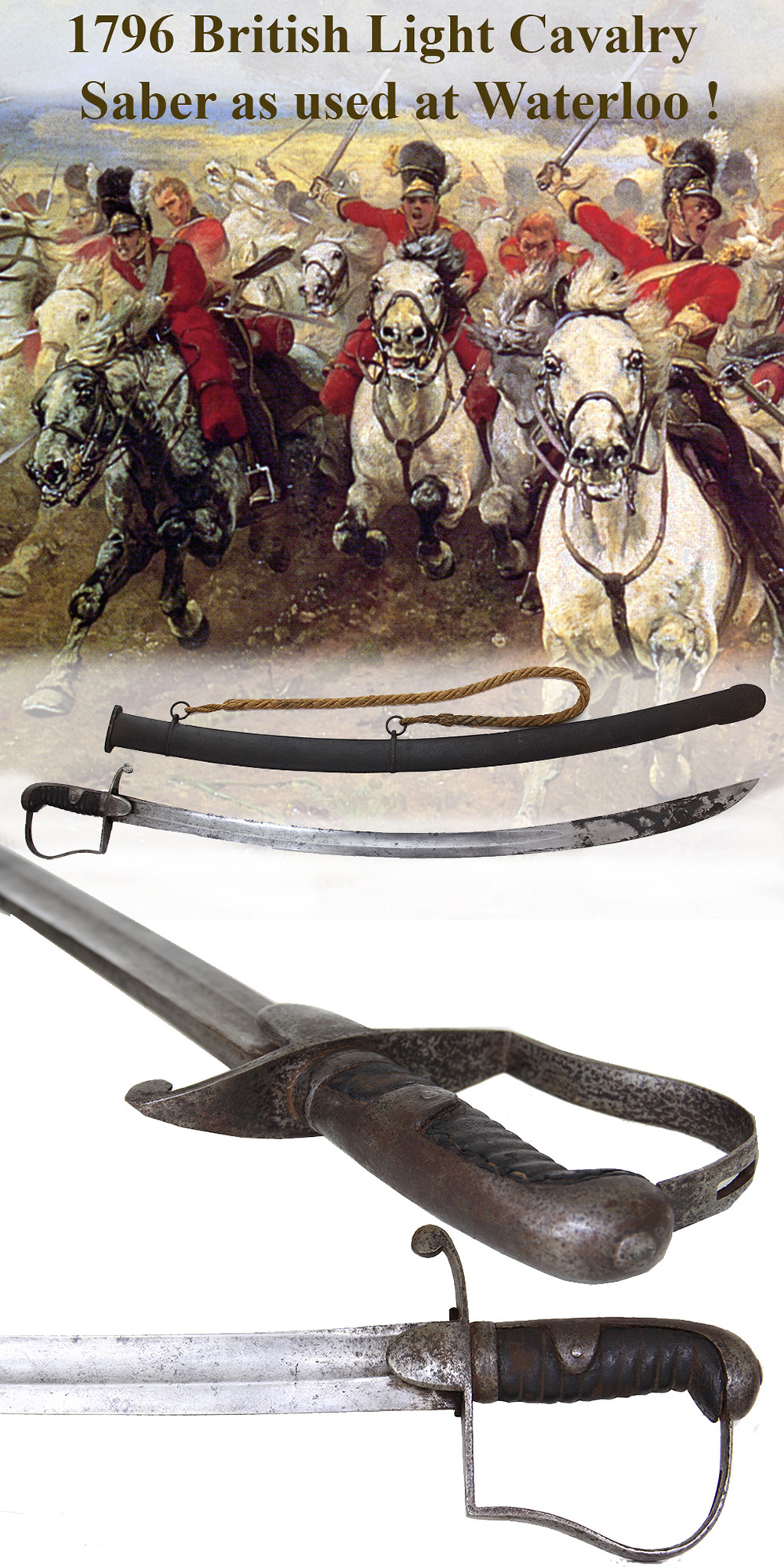
14-12-19 … British 1796 Pattern Light Cavalry Saber as Used at Waterloo …
It seems odd to call these substantial sabers light cavalry weapons, but they are distinct from the straight-bladed swords intended for the heavy cavalry and were a result of the fad for light troops, both infantry and cavalry, and are sometimes called Hussar sabers, after the well known Polish cavalry. This one is unmarked but shows all the signs of the typical British version that became regulation in 1796 and was widely copied, first by the Prussians then by we Americans as well. Iron mounts: stirrup guard with langets, birds head pommel with backstrap and ears, ferrule at base grip. Leather grip wrap is all there,the wire binding is long gone, but could be redone. Washer in place at blade shoulder. Blade has a good edge and is about 80% bright mixed with silver gray, but with some substantial dark areas near the tip from moisture settling in the scabbard. Some brown spotting to the guard as well. Typical brown iron scabbard with drag, carrying rings and substantial throat. The blade widens a bit toward the point to give a chopping edge to it that would be remembered by anyone on the receiving end of things. Someone added a braided cord to hang it and show it off. Fresh from a local auction where I bought it for dirt
… $550.00
Click Here to E-mail Us!
Call us @ 419-842-1863

14-12-20 … Attic Condition Pre-War Martial Colt 1851 Navy …
It s tough to find a real martial 1851 Navy and this one is as honest as they get. Here s a real attic condition, pre-war example that falls in the proper serial number range for government purchases, has the right oil-finished grips, and the correct US stamp under the Colt s Patent markings on the left side of the frame. Matching serial number 78411 on all parts including the wedge. 1857 is the year of manufacture. It is the Colt revolver issued to the dragoon and cavalry regiments on the western plains in the years immediately preceding the Civil War and they were still in service during the war. Crusty brown surface overall withlight dusting of standing rust, and fine surface pitting, but clear barrel address. The frame shows a mix of silver and brown, the hammer a bit darker, barrel and cylinder a crusty brown with some lighter spotsat high points, and salt-and-pepper light pitting overall. There is enough crust to obscure any subinspectors marks. The cylinder has no scene visible, it is buried in the brown patina, it shows a clear matching serial number. The brass has a mellow patina. The gun indexes and locks up well, with no wobble or looseness. The wood to metal fit is super and the grips are very fine,with just minor wear at the lower edges. No cartouche visible. Proper martial oil finish on the grips.The surface may clean with patience, care, and oil. My old friend Jim Wrenn in North Carolina could take a brown rusty gun and with a razor blade, a copper penny, and someoil could bring a metal surface back to life. Many times I watched him buy rusty guns at the Baltimore Gun Show and turn them into plum guns with hints of blue in the span of three or four hours. I do not have that talent so I have not attempted Jim’s trick here. A very good example of a very scarce Colt made in time for action with prewar US dragoon and cavalry regiments against Indians on the westernplains and southwest as well as use in the Civil War. Fresh from a local auction where I got a rebel saber
… $1,595.00 SOLD
Click Here to E-mail Us!
Call us @ 419-842-1863
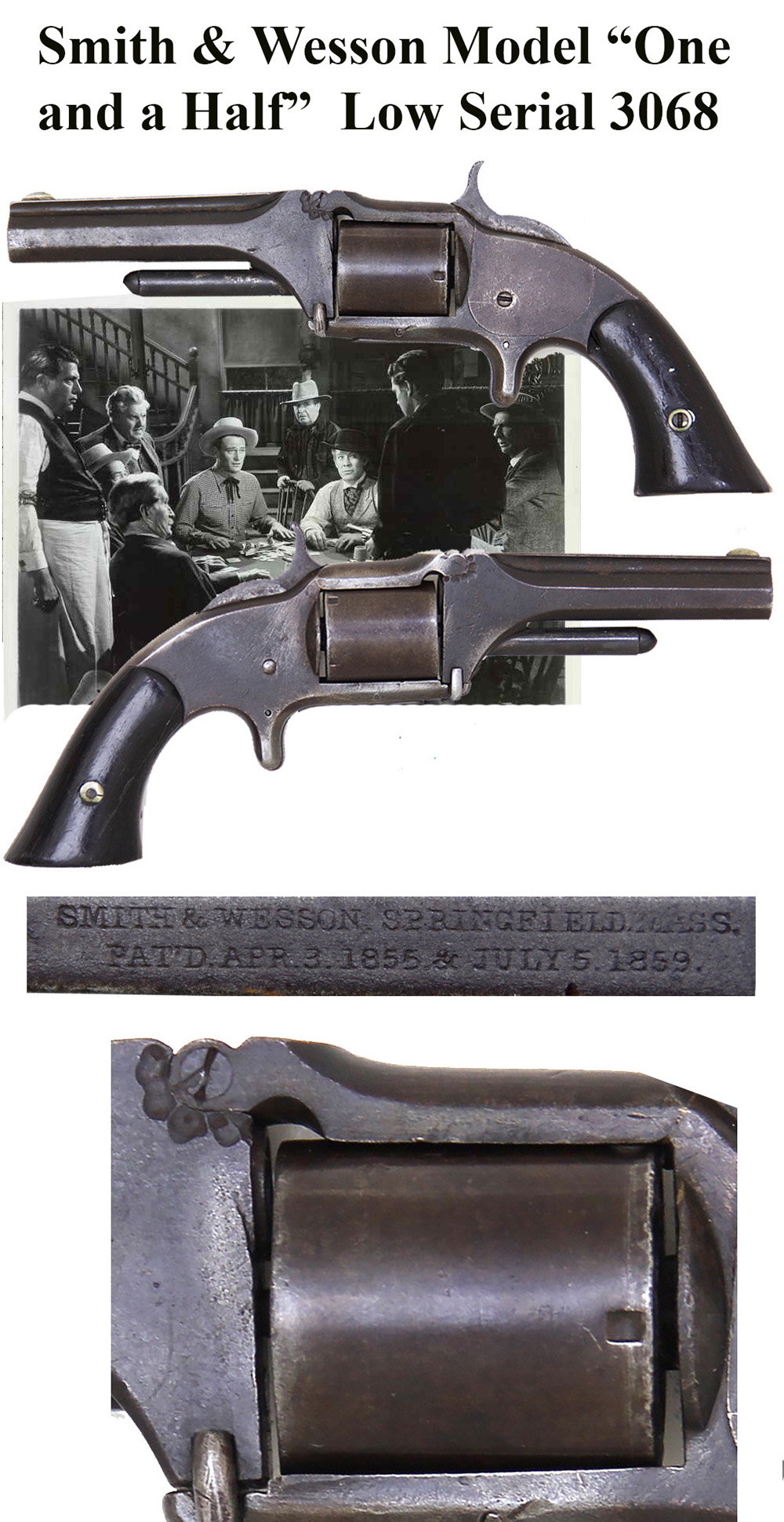
14-12-21 … Very Early Smith & Wesson Model 1-1/2:
This is the first issue 1&1/2 with flat butt and smooth cylinder. Serial is 3,068 which would put it in the first few months of production in 1865, the first year the gun was produced. The “first issue” guns were made for roughly three years in a quantity of around 26,000. The second issue guns with fluted cylinders and rounded butts were made until 1892 and are quite common, unlike the first issue examples. Overall very good condition. Standard 3-1/2 inch barrel. 32 caliber rimfire black powder. 100% original, 100% complete, mechanically perfect. Strong markings. VG grips with small (thin) repaired crack on the right side. There are some small peens on each side of the barrel lug just outside the hinge. These were done to tighten the hinge during the guns period of use … A very common disorder with the early top-break S&W revolvers. Perfect for late Civil War display, Wild West Gambler display, Saloon Girl get-up, or Indian War effects. A great early Smith and Wesson
… $395.00 SOLD
Click Here to E-mail Us!
Call us @ 419-842-1863

14-12-22 … Wonderful Solid Gold FORTY ROUNDS Identified Fifteenth Corps Badge …
The badge of the 15th Army Corps is well known among collectors for its no-nonsense approach to things: a cartridge box with an oval US plate on it and the motto forty rounds, . The 40 Rounds referencing a cartridge box’s full load of ammunition, which was four packs of ten cartridges each. These 15th Corps guys were ready for a fight.This is a magnificent jeweler made wartime specimen done entirely in gold and carried by the soldier on his watch chain. Beautifully engraved on the reverse by a talented jeweler: T.W. Ransom / Co. D 31st Iowa Inf t y Vol s. / 3rd Brig 1st Div. 15thA.C. They don t get much nicer! The face of the badge features the enameled cartridge box with its plate and motto centered in a plain gold field on a diamond with delicately engraved border and suspension loop at top. At some point the cartridge box, which is separately made and then attached to the diamond shaped backing, came off, likely from handling on the watch chain, and was reattached using a small screw from the rear, which unfortunately took off the A in Iowa in the inscribed regimental designation on the reverse. The soldier obviously cherished this piece of gold even after the war as it is currently attached to his watch chain from the later Victorian era. The chain even preserves his watch key! Theodore D.W. Ransom was from Fon Du Lac, Wisconsin, but enlisted at age 18 in the 31st Iowa on 10/20/62 and mustered into Co. D of the 31st Iowa on 10/30/62, He mustered out on 6/27/65 at Louisville, KY. The regiment first saw service in Arkansas and Mississippi, and eventually was made part of the 15th Corps from January, 1863, until its muster out, losing 1 officer and 27 enlisted men killed or mortally wounded during its service, which included more action in Mississippi, Alabama, and Tennessee under Sherman. It suffered casualties at Arkansas Post, Vicksburg, Lookout Mountain, Missionary Ridge, Ringgold, Resaca, Dallas, Kennesaw Mountain and Atlanta, Savannah and finally at Bentonville, after which it took part in the Grand Review and later mustered out with 370 of the original 970 men it had taken into service in the fall of 1862. Ransom must have been very proud of his service and the badge shows it. About as fancy as a corps badge gets … medal is 1-3/4″ in size measured diagonally … chain is adjustable in length, measuring over 12″ overall length
… $2,650.00
Click Here to E-mail Us!
Call us @ 419-842-1863

14-12-23 … Baltimore Marked Showy English Brass Barrel Box-Lock Flintlock Pistol …
Pretty box-lock flintlock pocket pistol with brass frame and brass screw-on barrel signed “W. Ryland” and “Baltimore”. These elegant little pistols were often cased as nicely as their larger cousins, and sometimes cased with them. This one is on the loose. They were a handy means of self-defense, or a defense of last resort. 7 ¼ inches overall, about .45caliber, this would pack a punch when loaded tightly from the breech. This one has a nice brass barrel and frame with mellow tones, some scratching and handling marks, but nothing bad. Nice view and proof marks on the under side, clear W. Ryland on one side flat, and Baltimore on the other!!!. I can find no reference to Ryland in London, Birmingham, or Baltimore. This seems clearly to be a marking for the American market. There is no town of Baltimore in England, and Lord Baltimore and King Charles are closely linked to the history of Baltimore, Maryland. Flat sided grips show a poorly repaired crackon either side that should be redone and an old inset round plug that could beleft as is. Even with the crack the pistol shows off very well. A most affordable early gun circa 1830 forthe Mid Atlantic US market
… $550.00
Click Here to E-mail Us!
Call us @ 419-842-1863
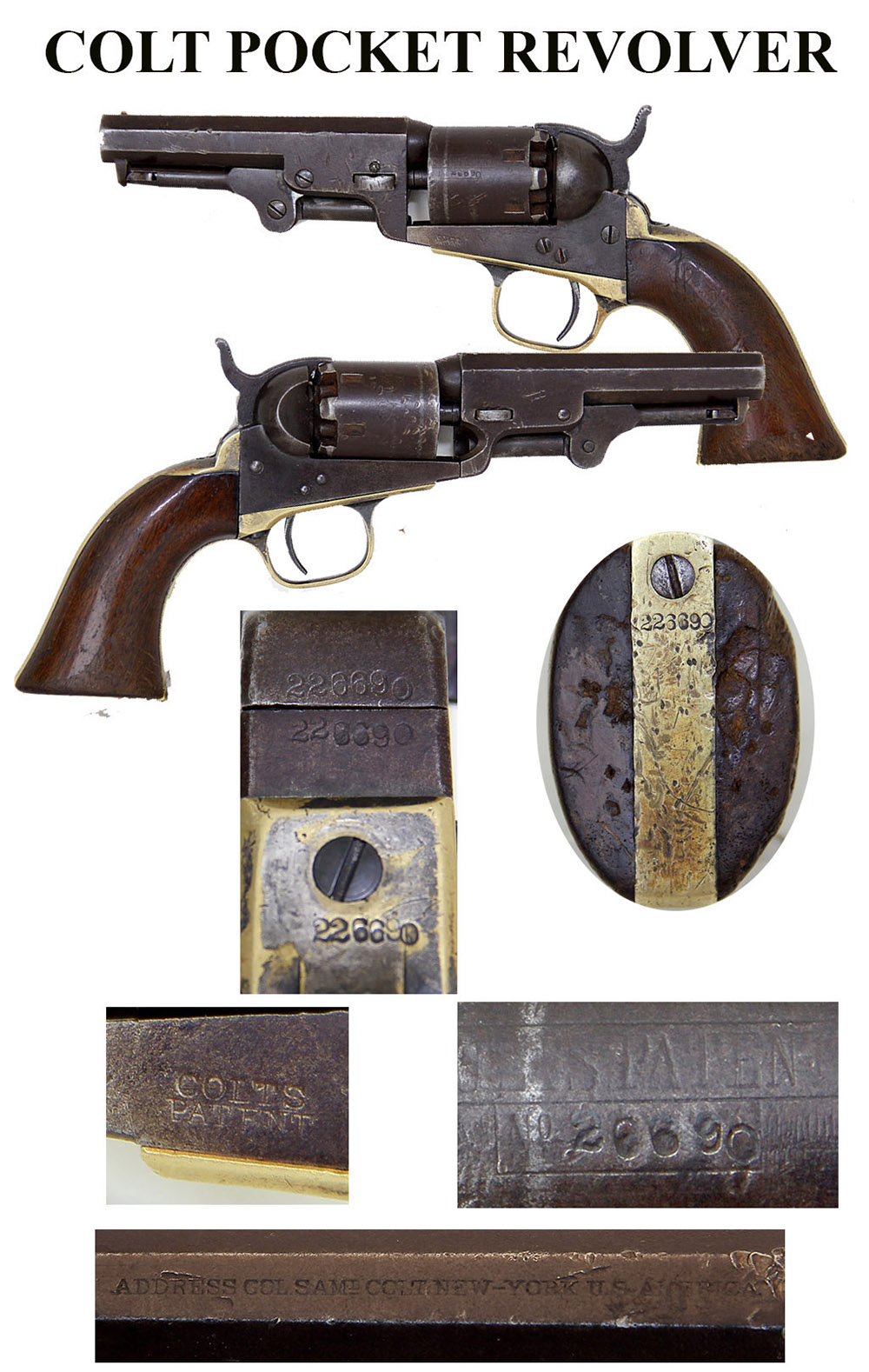
14-12-24 … Model 1849 Colt Pocket Wartime Manufacturer …
The .36 calibersix-shot Colt 49 pocket was an extremely popular gun with men headed west forthe gold rush and remained popular until the end of the percussion era. Thisone is a four-inch barrel version making it an easy revolver to carry and has faded blue turned plum brown color on the barrel, and traces of case on the frame, and a few bits of silver left on the brass. Some nicks and mars here and there, and some gray showing through, but matching serial number 226690 throughout, including the wedge. Clear barrel address and Colt s Patent markings. Cylinder scene is weak but theColt s Patent stamp and serial number cartouche are very visible. Varnished grips are nice, but with some wear at the bottom edge and some batter marks onthe bottom of the butt. The serial number dates the pistol to 1863 making it good for an early western collection or an example of a wartime officer s sidearm. A good solid Colt
… $850.00 SOLD
Click Here to E-mail Us!
Call us @ 419-842-1863
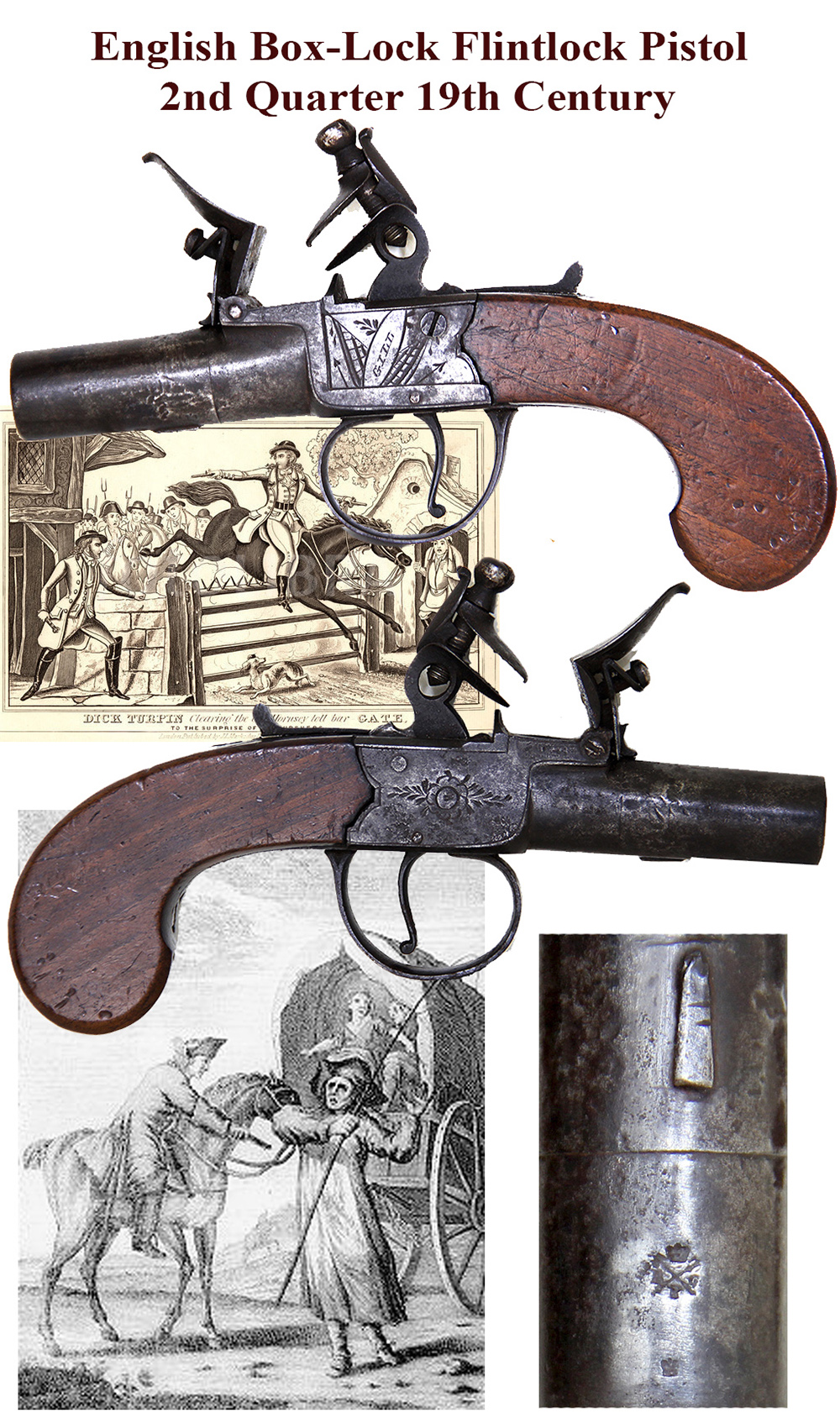
14-12-25 … English Box-Lock Flintlock Pistol by Gill
… Near fine condition… These were the British derringers of the early era: small pocket pistols that could be carried discreetly for self-defense by gentlemen in town, travelers, and even the military officer: Stephen Decaturhad a pocket pistol something like this when he shot a Barbary pirate he was wrestling with in a close-quarters boarding action. Plain, flat-sided grips with some dings and handling marks, but no breaks. 6 ¼ inches overall, about.45 caliber. Nice marking of “Gill” (the well known British arms maker anddealer) between some rudimentary flags, etc., on the side plate. Short turn-off barrel with lug enables the pistol to be tightly loaded at the breech, meaning it can fire a “forced ball” with much greater power at short range than you would think. Faded blue on the steelgiving a stronger purple toward the muzzle and mixing with gray toward the back. A nice little gun
… $550.00
Click Here to E-mail Us!
Call us @ 419-842-1863
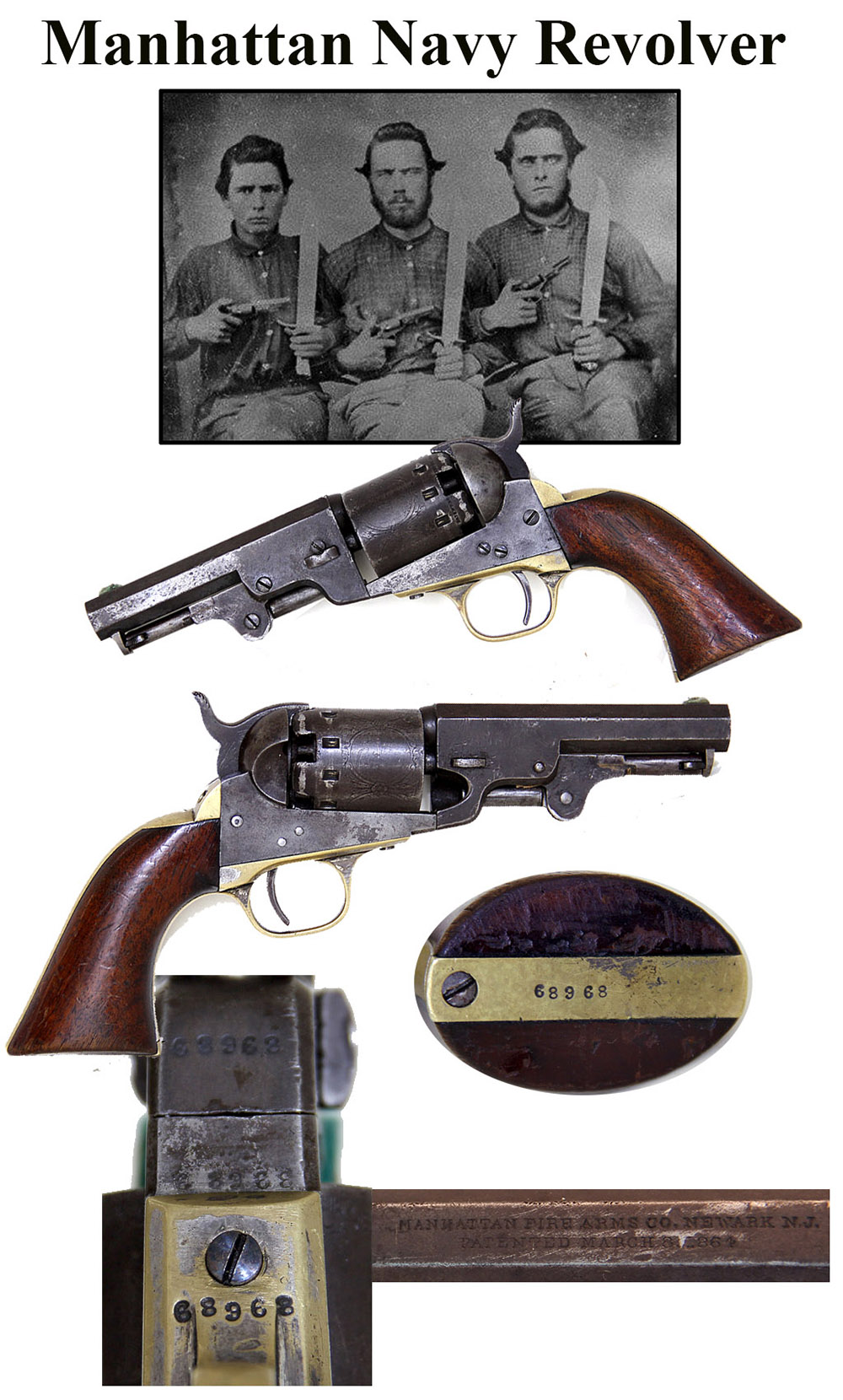
14-12-26 … Manhattan Navy Revolver …
Very good condition Manhattan Navy Revolver with 4-inch barrel, 12 cylinder stops. These 5-shot .36 caliber revolvers were the company s attempt to compete with the Colt Navy, but also with the market for pocket revolvers, and they were pretty successful making about 78,000 of these pistols in several different types until 1868. This one has lots of oxidized blue (plum) on the right side of barrel. Itis weaker on the left side, probably stored lying on that side, going to about 30 percent plum, balance grey, with some bright areas on the left central flat. Thecylinder has nice plum patina with the exception of a dragline over the nipples. It shows some cylinder sceneand there are some mottled gray traces of case on the frame below the cylinder,mostly to the rear. Matching serial number 68968 throughout, and a clear two-line barrel address: Manhattan Fire Arms Co. Newark N.J. / Patented March 8, 1864. Nice grips, very tight fit all round, some minor handling marks and scratches. A very nice gun
… $695.00 SOLD
Click Here to E-mail Us!
Call us @ 419-842-1863
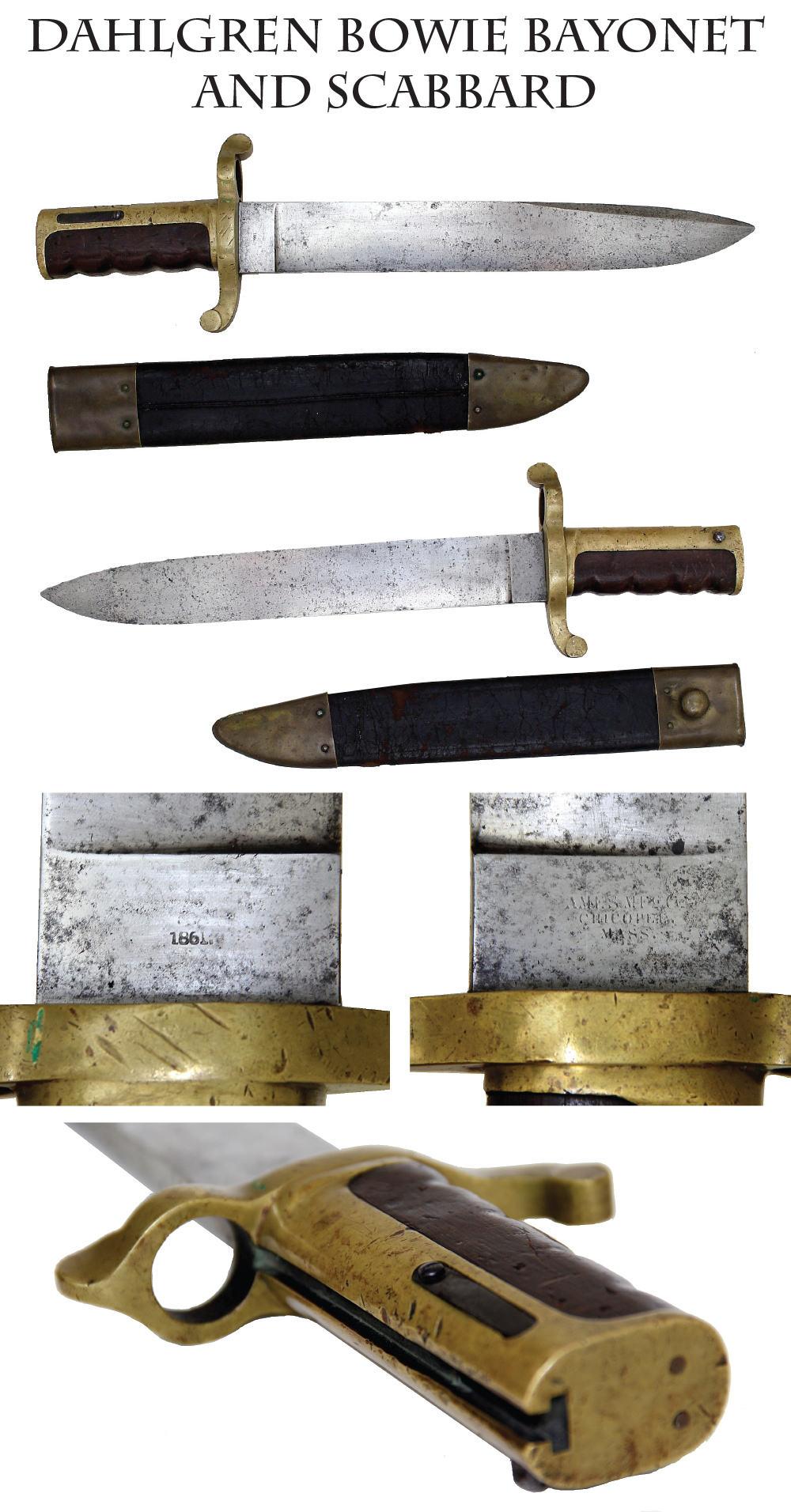
14-12-27 … Dahlgren Bowie Bayonet
… One of the most highly sought of all Civil War knives / bayonets. This deadly edged weapon fit the iconic Whitney-Plymouth Navy Rifle. Overall VG to near fine condition. Complete with original brass mounted scabbard. Nicely marked with 1861 date and full Ames firm markings … blade is 12″ in length … handle is 4 1/2″ for 16 1/2″ total length
… $1,650.00 SOLD
Click Here to E-mail Us!
Call us @ 419-842-1863
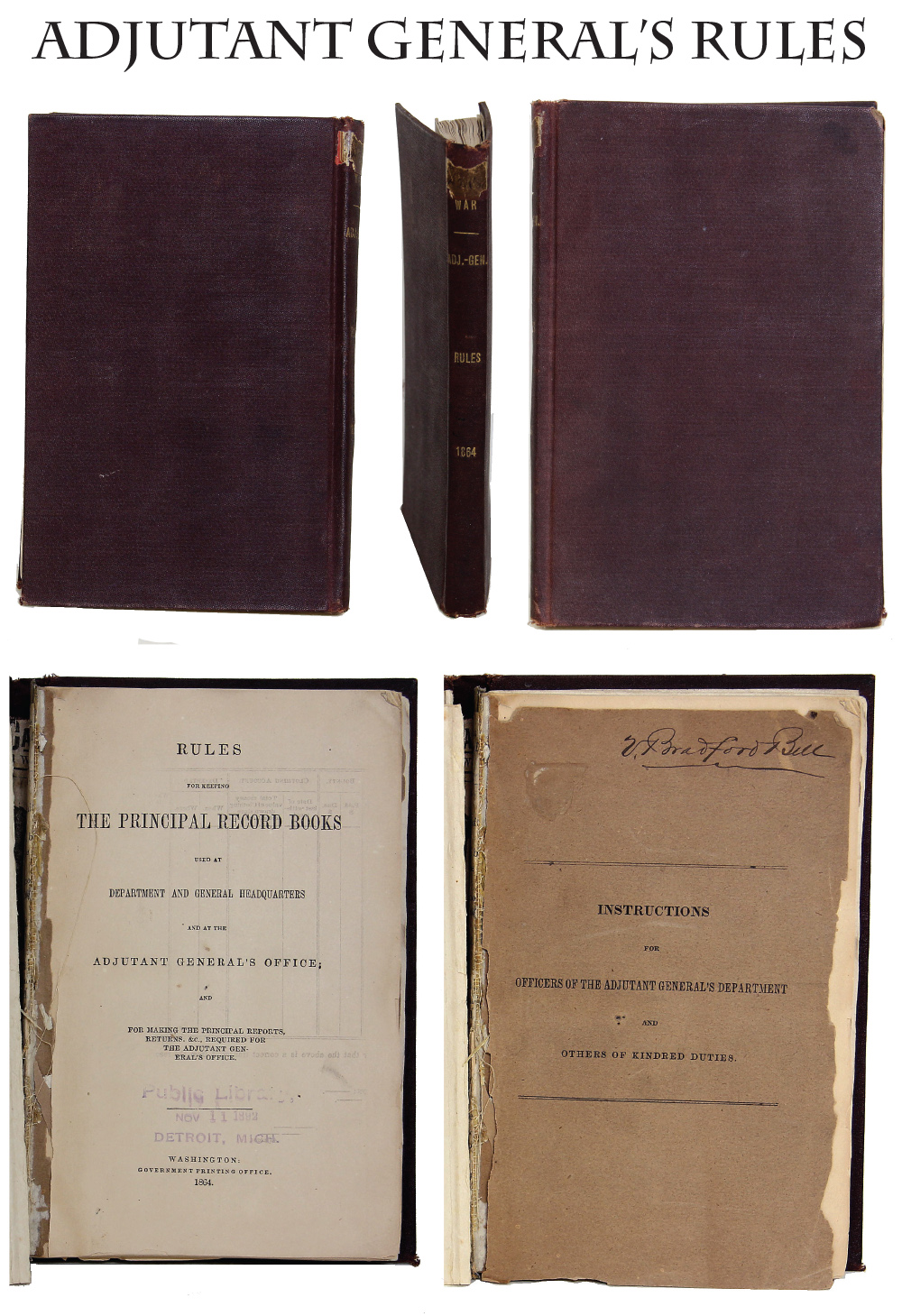
14-12-28 … 19th Illinois Infantry Inscribed 1864 Rules and Instructions for Officers of the Adjutant General s Department.
The administration of vast armies in the field was something new for the War Department and there was always a struggle to keep officers up to date and avoid having a large bureaucracy fall into chaos. Here are two publications from the Adjutant General s Office in the War Department for the instruction of its officers: Rules for Keeping the Principal Record Books Used at Department and General Headquarters, etc. and Instructions for the officers of the Adutant General s Department and Other Kindred Duties. These were paper bound and then subsequently bound together in a brown cloth binding that is now broken at the spine. One cover sheet is missing but the contents are all there. The name V. Bradford Bell appears at the top of the remaining cover sheet. This is Vincent Bradford Bell of the 19th Illinois Infantry. He enlisted from Chicago on 6/4/61 and quickly went from Private in Co. K to Sergeant Major and then to Second Lieutenant of Co. K on10/20/61 and mustered out 7/9/64. Bell was wounded three times, the most severely at Stones River: the bullet striking him at the outer corner of the right eye, making an indentation in the skull, glancing around the head, and coming out about an inch back of the left ear. He was left for dead on the field, taken up by Confederates with other wounded officers, but refused to give his parole and eventually made his way back to Union lines. A fellow officer testified in apension hearing that he was one of the bravest men I ever knew. He was reported to have turned down promotions to other regiments. In October, 1862, he defended a stockade defending a railroad bridge with thirty-five men against a reported regiment of Confederate cavalry, refusing demands to surrender. While on leave after being wounded he was chosen by citizens in Chicago to present a new set of colors to the regiment. He was reported to be a man of fine character, great ability, and correct habits after the war, but his war wound caused him periods of great pain and temporary insanity, to escape which he placed a pistol to his head and blew out his brains in 1880. From his possession of these regulations it would appear that he acted at some point as the regimental adjutant or perhaps on a brigade staff. That part of the story could be very interesting as well. Roughly 3/4s of an inch thick. 100 pages plus numerous large fold-outillustrations. Quite a rare book … book size 5″ x 7 1/2″
… $175.00 SOLD
Click Here to E-mail Us!
Call us @ 419-842-1863

14-12-29 … Custer’s Michigan Cavalry Brigade ID D US Army 1861 Regulations …
This is a well used, but still solid a presentable copy ofthe US Army 1861 Regulations, that every officer was supposed to know and abideby. Covering everything from uniform regulations to ranks and responsibilities, duties, proper forms and paperwork, etc., etc. It is not overstatement to call it the bible of the commissioned officer in the army. This one has a great association, being owned and inscribed by three different men, all members of the 7th Michigan Cavalry, part of the George Armstrong Custer s famous Michigan Cavalry brigade, and the first owner was not only a company commander but became regimental Major and Lieutenant Colonel. The inner flyleaf bears a wonderful and elegant ink inscription: Capt. D.H. Darling / 7Regt Michigan Cavalry / Grand Rapids/ Michigan Darling was 24 years old when he enlisted 11/13/62 at East Saginaw and commissioned to date the same day as Captain of Co. C. He made Major 3/22/64 and Lt. Colonel 5/26/65, and mustered out 12/15/65 at Jackson, Michigan. At some point the volume made its way to two sergeants in the regiment who added their names to the outer side of the flyleaf as well: Sergt. H.D. Benham / Co D 7th Mich Cav. is written rather neatly and then Sergt. B.H. Deming and B.H.Deming is written above and below that, implying Benham had it first. Henry D. Benham enlisted 9/4/62 and mustered in as a sergeant in Co. D on 11/13/62 and served until discharged for promotion on2/24/64, to 1st Lt. Co. B of the 1st Michigan Colored Infantry, with whom he served until 7/3/64 when he died of disease at Beaufort, SC. It may have been that Darling gave him the volume while he was studying to apply for the promotion. In any case, it must have soon gone to Benajah Deming or Demmings, who actually left the regiment a few weeks before Benham: he was 44 years old when he enlisted 9/16/62as a sergeant and mustered into Co. B of the 7th Michigan Cavalry, serving until discharged on 2/13/64.The history of the regiment and brigade is too long to go into here: suffice it to say they started fighting in early 1863 and did not stop until the end of the war. CW Data gives 129 occasions when they were engaged and lost men. They fought in every great cavalry engagement of the Army of the Potomac: at Gettysburg they lost 14 killed and 37 wounded, they pursuedLee, fought Mosby, and had a hand in killing J.E.B. Stuart at Yellow Tavern. This is great piece of history. Custer!!! 6″ x 8 3/4″
… $495.00 SOLD
Click Here to E-mail Us!
Call us @ 419-842-1863

14-12-30 … Mahan’s 1862 Treatise on Field Fortifications
Brown cloth binding with some edge chips at top of spine,otherwise solid. Revised third edition, published in New York, 1862. A keyreference for understanding field fortifications. We sometimes think of the warstrictly as a progression from open field fighting to the entrenchments of Petersburg, but as this volume makes clear, officers were expected from anearly date in the war to understand not only permanent fortifications but methodsof laying out, constructing, defending, and attacking intrenchments. A pocket sized volume, about 4 by 6 inches,. This book along with army regulations andtactics volumes are key parts of any officer s display, and a key part ofunderstanding how the army operated in the field. 168 pages with many fold-outs. Very scarce … 4″ x 6 1/4″ size
… $195.00 SOLD
Click Here to E-mail Us!
Call us @ 419-842-1863

14-12-31 … Joslyn .44 Cal. Cavalry Revolver with ULTRA RARE Holster
I just purchased these from the family descendants in Wisconsin. This holster is much rarer than the pistol, and a Joslyn is not a common revolver by any means – only about 3,000 were made in 1861 and 1862. This one bears serial number 189. The holster is adorned or reinforced along the edge of the cover flap with substantial brass rivets. I do not know if the holster was made with the rivets or if they were added by the soldier. My feeling is that they were put on at the factory or arsenal. I owned one Joslyn holster earlier last year that bore no such rivets, but this example appears to have been made with the rivets. There is wear on the leather, a few rivets are missing, the latch tab is gone, and there is some seam separation. The revolver is overall good to VG with two solder repairs where the back strap meets the frame and also where the inside grip strap meets the frame … the result of some nit-wit using the butt as a hammer and cracking these spots which the family then solder repaired. See photos which show the repair. Has clear Joslyn maker and patent markings, low serial number (189), smooth metal. Blued finish gone except for hints in protected areas. Some darker color near the muzzle, mostly a neutral dull silver, but cylinder shows some blue with a drag line at the rear. Checkering on grips is very good, showing wear but not worn excessively. The inboard grip, however, has a major crack that needs fixing and some chipping at the base showing where the nit-wit used it to pound something down. The holster is a military configuration and fits the revolver perfectly, and it has been with the Joslyn since the war. No toe plug, as is frequently the case on any CW holster. Minor abrasion and finish loss. A scarce set. It needs a tune-up mechanically. The cylinder will rotate when the hammer is cocked but the hammer will not stay on full cock. I will leave this project to you. This Joslyn and holster were definitely carried together in the Civil War. Cavalry? Navy?
… $2,250.00
Click Here to E-mail Us!
Call us @ 419-842-1863
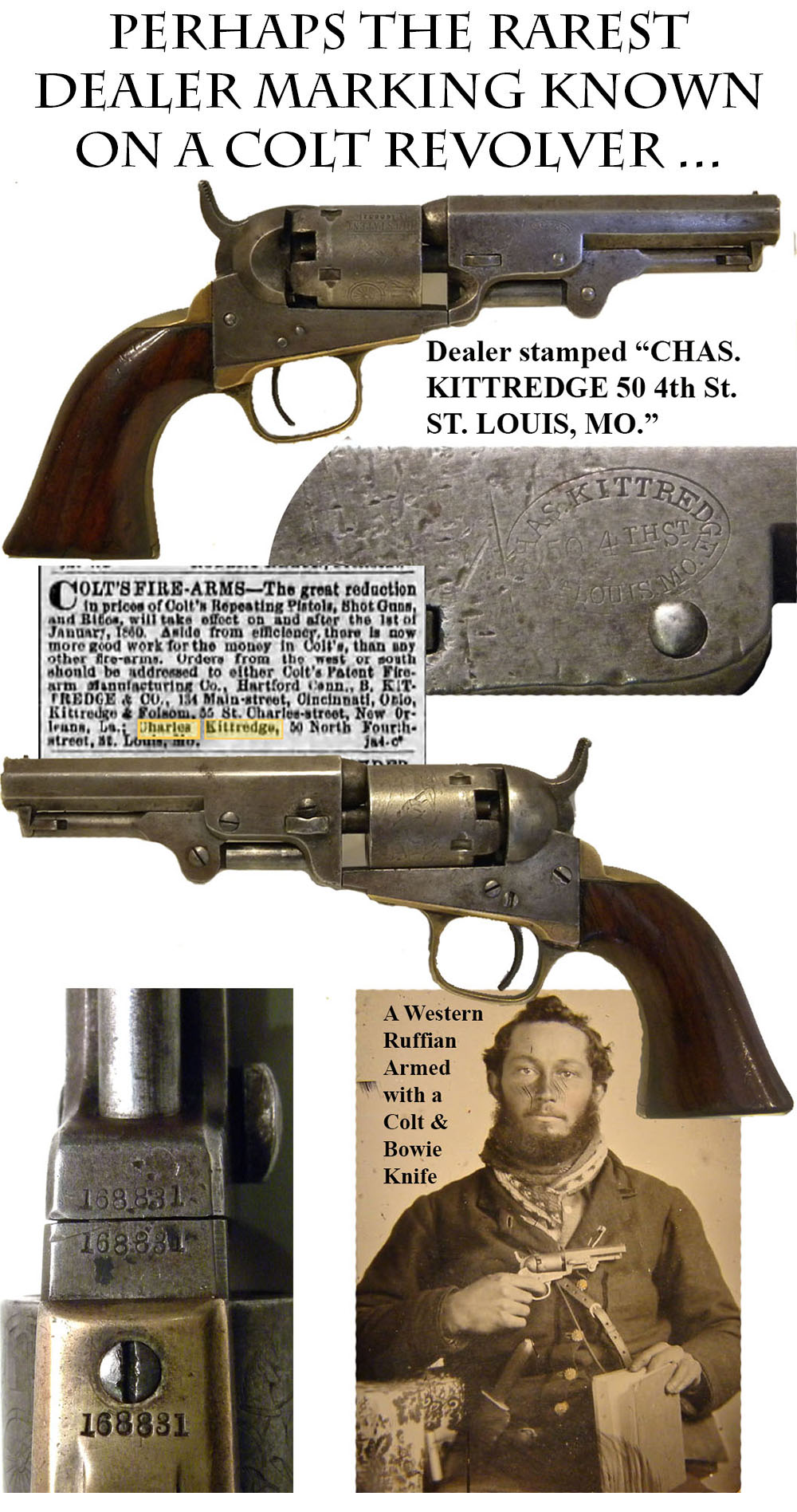
14-12-32 … Perhaps the Rarest Dealer Marking Known on a Colt Revolver:
We are all familiar with gun dealer and outfitter Benjamin Kittredge of Cincinnati whose name is found stamped on innumerable arms and related accoutrements of the 1860s. His store in Cincinnati is legendary. But this wonderful four inch barrel Colt Pocket revolver is beautifully stamped “CHAS. KITTREDGE 50 4th St. ST. LOUIS, MO.” This is the first such marking I have encountered in nearly 45 years of collecting and trading guns. The revolver is a very solid Model 1849 Colt Pocket revolver with four inch barrel. It has a two line bracketed New York barrel legend, and five shot cylinder. Condition is NRA “very good ++”. Retains most of the stagecoach holdup cylinder scene. All serial numbers are matching 168,831 including the wedge. It is 100% original. 100% complete, and mechanically perfect. This Colt surfaced at a Cincinnati auction earlier this year. I was fascinated by the marking and bought it. I showed the marking to several very ADVANCED Colt collectors including Bill Myers here in Toledo, and Compton LeBeau of New Orleans … neither had seen the marking previously. I then set about researching period newspapers which was difficult as St. Louis papers from the period are not readily accessible. What I found was quite telling. During the first week of January 1860 … in three issues of the Cincinnati Daily Press Ben Kittredge advertised a sale on Colt firearms … and in those three ads ONLY — he lists Chas. Kittredge of 50 4th Street in St. Louis as one of his dealer agents. I will assume that Charles was a brother or cousin. But aside from the three ads in January I can find no other mention of Charles Kittredge in any of Ben’s ads. Perhaps he died? … cast his lot with the South? … left for places unknown??? I will leave the additional research for you to complete. This Colt is truly a wonderful piece of frontier Americana. St. Louis was the jumping off point for all western adventurers and most of the wagon trains going west. This wonderful 1860 era Colt with unquestionable western connection is one of the most interesting arms I have been fortunate enough to find. Unique in my experience
… $2,250.00 SOLD
Click Here to E-mail Us!
Call us @ 419-842-1863
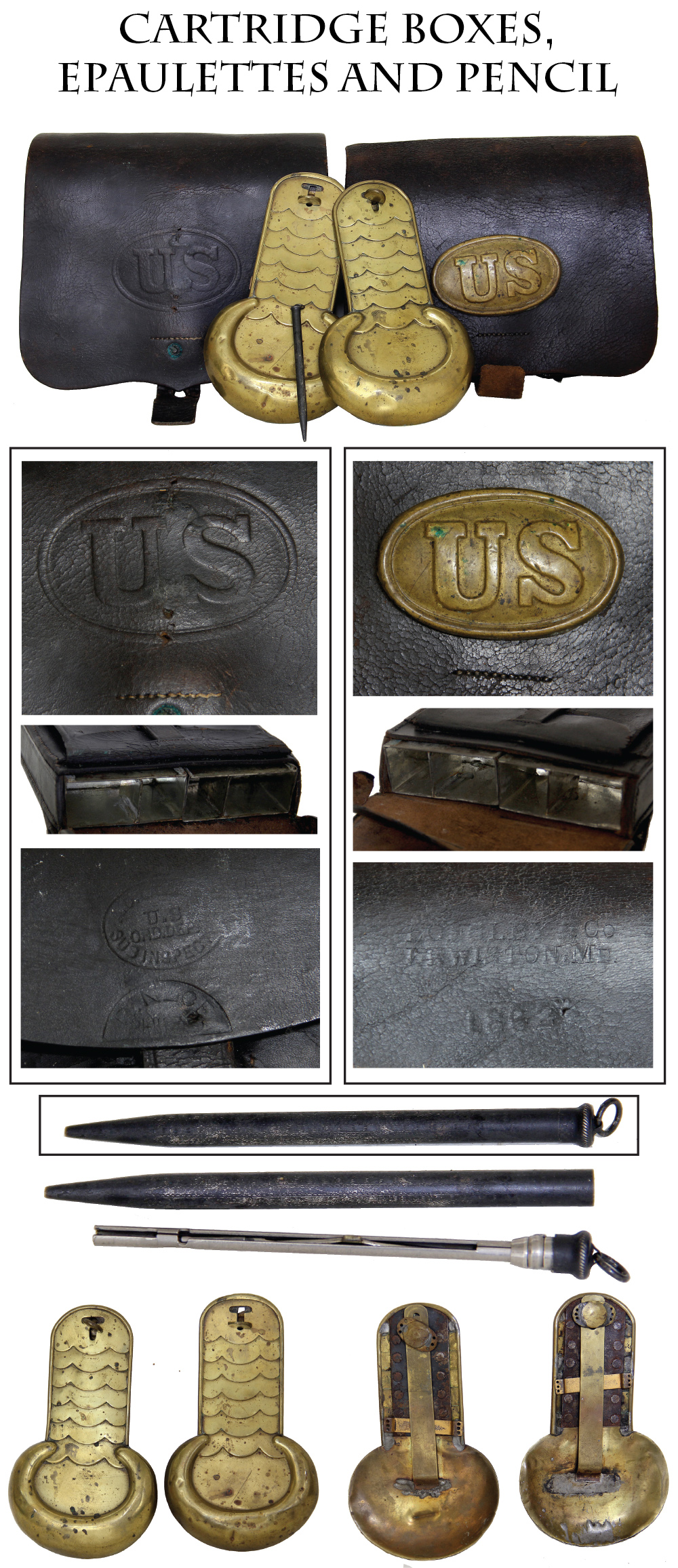
14-12-33 … 1864 US Cartridge Box
… Complete and in fine to excellent condition. Nicely embossed US on the front cover. Has both tins. Strong markings. All straps and buckles firmly intact
… $375.00
14-12-34 … Cartridge Box with Box Plate
… Made in State of Maine / 1862 US Cartridge Box and US Plate with Rare 1862 Date: Complete and in fine to excellent condition. Has attractive original oval US cartridge box plate on the front flap still held in place with the original thong. Has both tins. Very scarce maker… Longley & Co. / Lewiston, Maine … and dated 1862. All straps and buckles firmly intact
… $495.00 SOLD
14-12-35 … Regulation Civil War Shoulder Scales –
These are the light weight brass decorations worn by enlisted men on the shoulders of their frock coats and shell jackets, ostensibly for the purpose of warding off saber blows from mounted attackers. These proved to be just so much fluff and the common sense soldiers threw them away once they got in the field. When seen in photos they are on the uniforms of newly uniformed troops or those stationed in close proximity to bureaucratic authority. 6 1/2 inches in length. This pair is in excellent condition and is complete with the attaching keys
… $245.00 SOLD
14-12-36 … Sterling Silver Mechanical Pencil:
Solid silver body. Circa 1900 … works perfectly… looks like a CW era example. Perfect for living history, diary display, or use by a rich lady who likes nostalgic writing instruments. Buy it for your wife. It will clean up and shine beautifully. I just haven’t had the time
… $75.00
Click Here to E-mail Us!
Call us @ 419-842-1863

14-12-37 … Remington Cowboy Derringer:
Type 2 Remington .41 Caliber Double Derringer: A more classic Wild West gambler’s gun cannot be found. Virtually every Western movie made included someone carrying one of these derringers. This specimen made circa 1880s to 1890s. Overall VG condition. Batch numbered 469 under the barrels. Mechanically perfect. 100% original. Close inspection with a high power magnifier shows a nearly invisible hairline fracture in the right side of the hinge at 7 o’clock. So this should NEVER be shot. But who wants to shoot it anyway … It’s a good old antique gambler’s gun from the days of Wyatt Earp and his pards
… $550.00 SOLD
Click Here to E-mail Us!
Call us @ 419-842-1863

14-12-38 … A lot of TEN Original Indian War Large Size Eagle Coat Buttons.
A few years ago at an eastern Pennsylvania auction I bought a couple large bags full of these early Indian Fighters buttons and then I put them aside and forgot about them. I just stumbled across them again …. So here is a great opportunity…. ten original buttons for $25.00 These can be mailed inexpensively in a padded envelope.
… $25.00 for 10
Click Here to E-mail Us!
Call us @ 419-842-1863
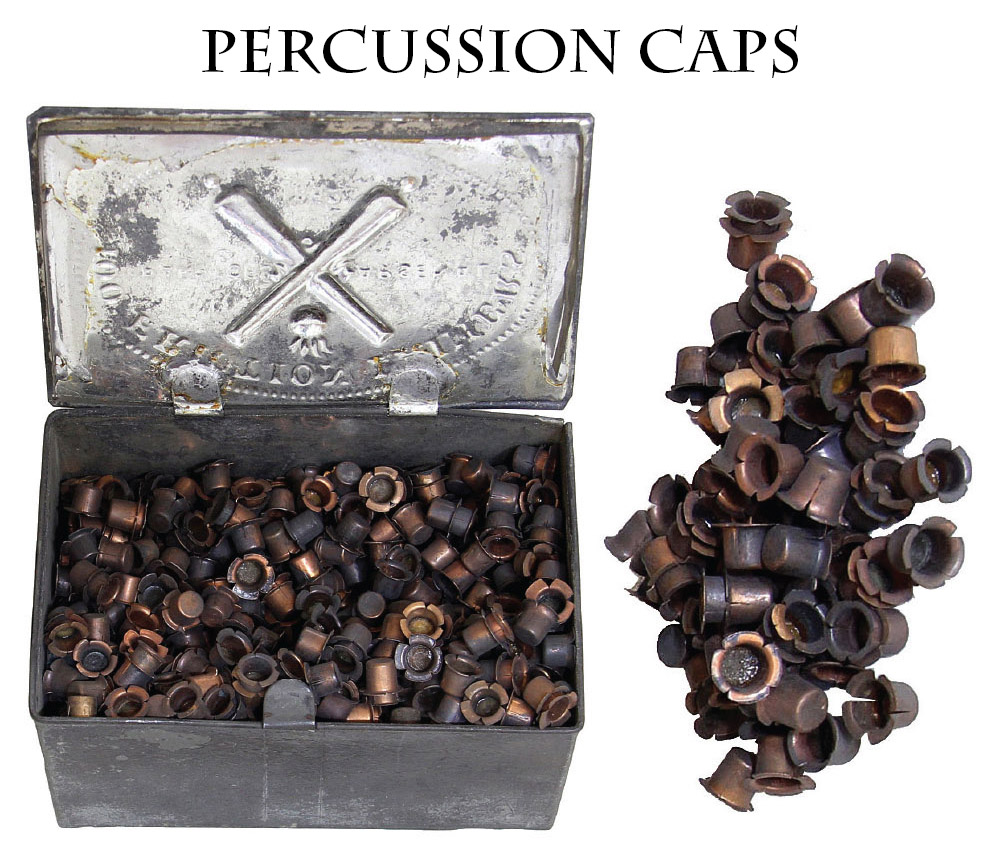
14-12-39 … Friction Primer Tin [Tin not for sale] and Percussion Caps …
I just purchased this neat old relic and am offering the percussion caps inside the tin in this offering. This very scarce tin came just as you see it, filled with percussion caps for muskets. The tin itself is the arsenal tin used to hold artillery friction primers. These are darned hard to find! I can only think of one instance where I found one still in a primer pouch! The tin has a hinged cover with small latch and embossed top reading: 100 FRICTION PRIMERS in an arc over an ordnance insignia, and FRANKFORD ARSENAL on either side. I don t know who put the percussion caps in the tin, it was certainly a handy storage idea, but since they do not belong together, I am splitting up the lot.
In each package of ten cartridges the soldier got 12 caps. While the supply lasts I will sell the percussion caps …
One Dozen … … … $15
Two Dozen … … … $25
Five dozen … … … $50
Click Here to E-mail Us!
Call us @ 419-842-1863
Layaways are Welcome
Need to split your order into multiple payments? No problem! A simple 20% earnest money deposit will hold your item for you.-acf
You can then pay it off in easy installments that fit your budget.
Read Terms Here
Items to Sell? Contact Us
I am always interested in buying ANYTHING from the American Civil War… Guns, Swords, Civil War Muskets, Knives, Uniforms, Flags, Medals, Badges, Diaries, Letters, Autographs, Buttons, photographs, tintypes, daguerreotypes, Insignia, Camp Items, Battlefield Relics, canteens, Drums, Etc… Call 419-842-1863 and ask for Dave Taylor.

